Ford’s ever-popular Ranger lineup is more complicated than ever, but the one you see here – or rather its engine – won’t be available from next year.
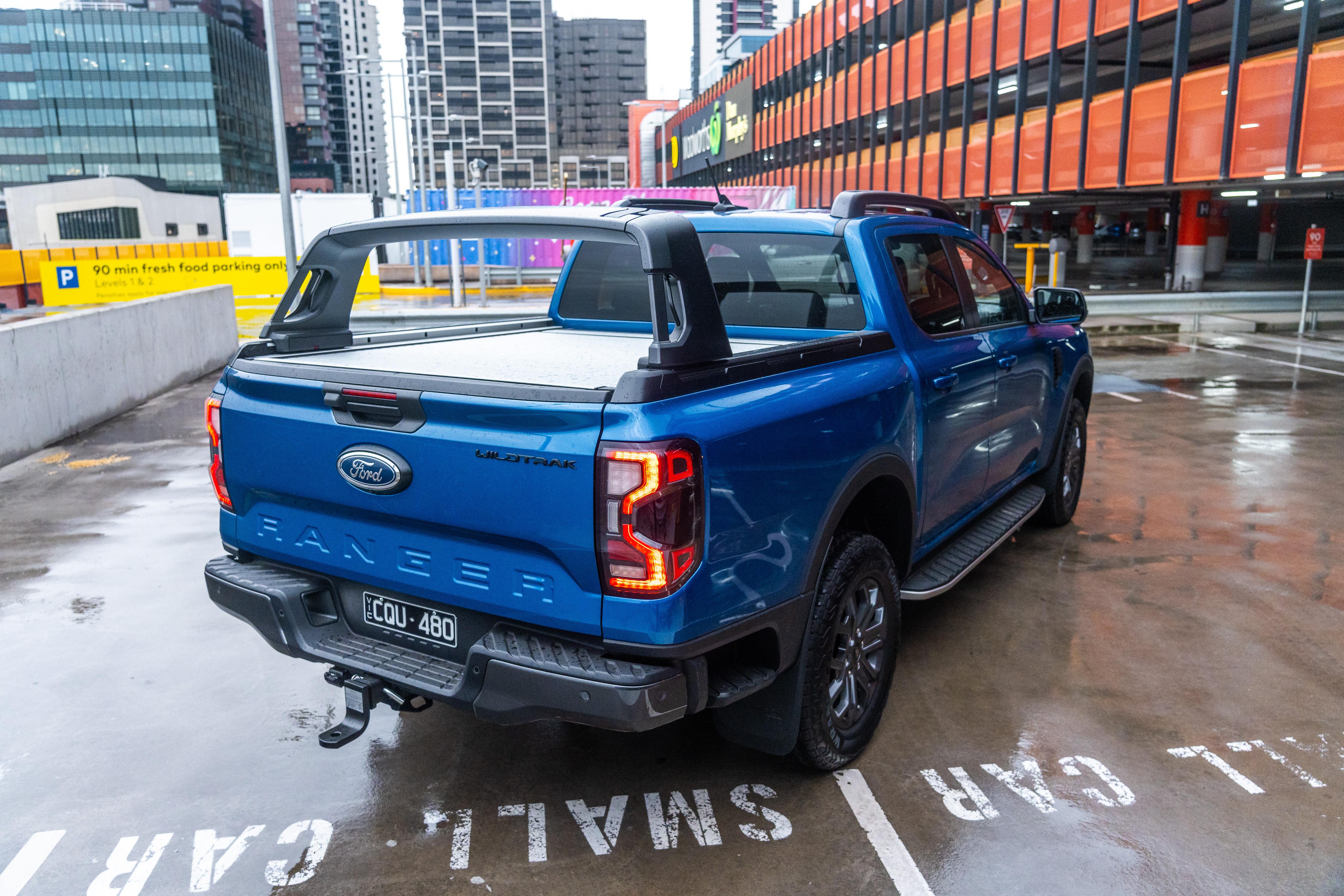
There are now five different engines, as many as 25 individual variants, and more mismatching between trims and specifications than you’d reasonably expect from the average sock drawer.
But worry not, because among the chaos there’s still a plethora of more traditional utes to choose from. New plug-in hybrid (PHEV) versions are now available, but diesel engines are still the norm, and there are all sorts of body styles on offer to suit the needs of all types of buyers.
Among them is the popular version you see on test here. The 2026 Ford Ranger Wildtrak 4×4 bi-turbo dual-cab pickup is soon to disappear as an individual variant, following the recent announcement that Ford will discontinue the bi-turbo engine after 2025, although the V6 version will continue.
Being a Wildtrak, it is only available as a dual-cab pickup, with part-time four-wheel drive fitted as standard. That makes it one of the best-suited all-rounders in the Ranger lineup, at least on paper.
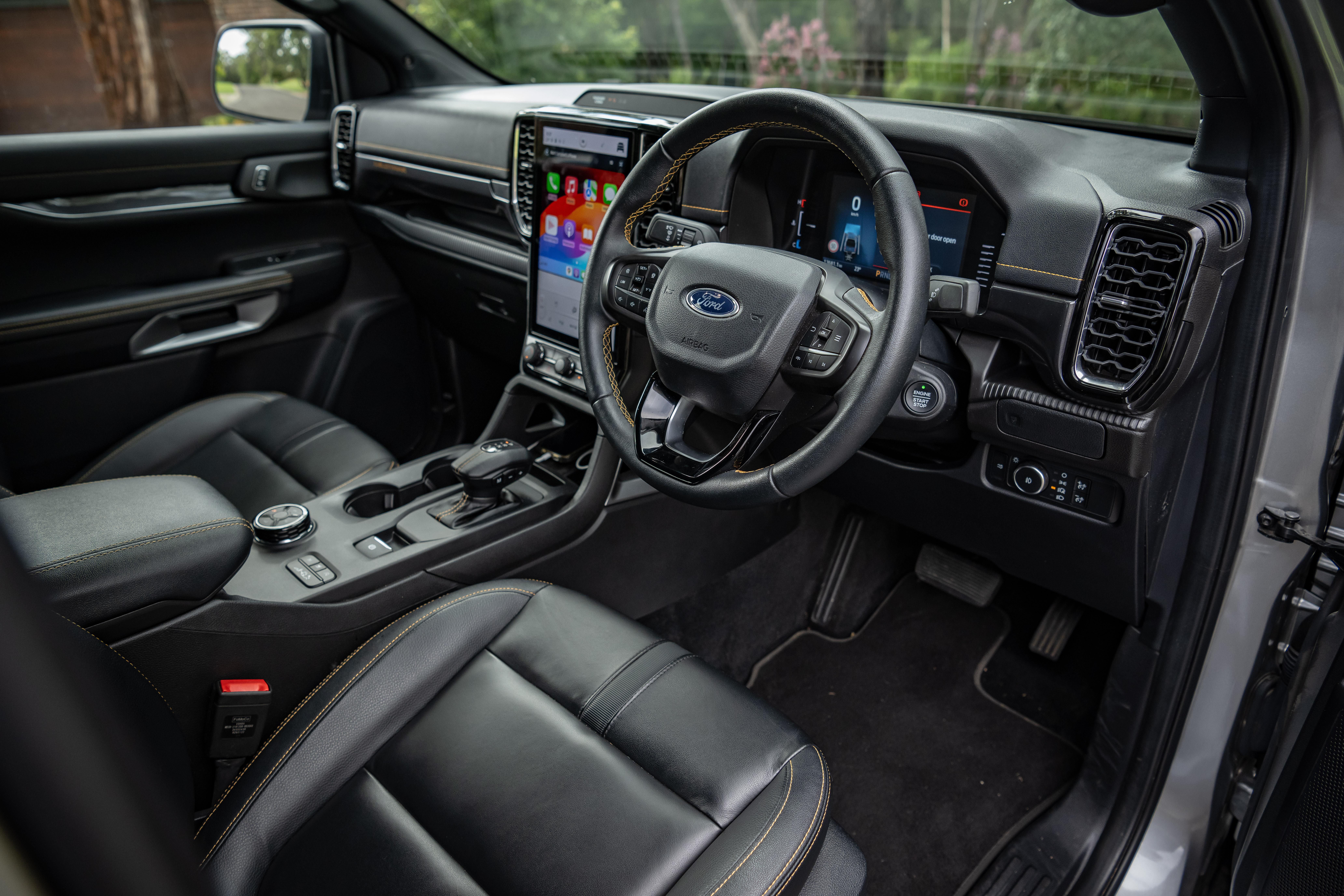
Of course, the Ranger remains Australia’s best-selling vehicle this year, even if it jostles with either Toyota’s HiLux ute and RAV4 mid-size SUV for the top spot each month.
With more than 40,000 deliveries recorded to the end of September 2025, the Ranger is comfortably clear of the HiLux (~35,000) and on another planet compared to segment stalwarts like the Isuzu D-Max. Its sales are dominated by 4×4 vehicles, as the HiLux has the edge in fleet-oriented 4×2 mules.
Even with the influx of new utes with various powertrains, it’s clear the Ranger is still firmly in charge of Australia’s ute segment, whether the average motorist likes it or not.
What is it about the Ranger that keeps buyers flooding into showrooms, and is the Wildtrak the sweet spot in the lineup?
How much does the Ford Ranger cost?
Prices have been nudged higher for the Ranger, with the Wildtrak 4×4 bi-turbo listed at $69,890 before on-roads. That’s $250 more than the asking price at this time last year.

Ranger XL
| Model | Price before on-roads |
|---|---|
| 2026 Ford Ranger XL 4×2 single-cab/chassis | $37,130 |
| 2026 Ford Ranger XL 4×2 super-cab/chassis | $39,630 |
| 2026 Ford Ranger XL 4×2 dual-cab pickup | $43,530 |
| 2026 Ford Ranger XL 4×4 bi-turbo single cab/chassis | $48,230 |
| 2026 Ford Ranger XL 4×4 dual-cab/chassis | $49,230 |
| 2026 Ford Ranger XL 4×4 bi-turbo super-cab/chassis | $50,730 |
| 2026 Ford Ranger XL 4×4 dual-cab pickup | $51,130 |
| 2026 Ford Ranger XL 4×4 bi-turbo dual-cab/chassis | $52,730 |
| 2026 Ford Ranger XL 4×4 bi-turbo double-cab pickup | $54,630 |
| 2026 Ford Ranger Black Edition 4×4 bi-turbo double-cab pickup | $57,000 (drive-away) |
Ranger XLS
| Model | Price before on-roads |
|---|---|
| 2026 Ford Ranger XLS 4×4 bi-turbo dual-cab pickup | $57,880 |
Ranger XLT
| Model | Price before on-roads |
|---|---|
| 2026 Ford Ranger XLT 4×2 bi-turbo dual-cab pickup | $56,690 |
| 2026 Ford Ranger XLT 4×4 bi-turbo super-cab pickup | $61,890 |
| 2026 Ford Ranger XLT 4×4 bi-turbo dual-cab pickup | $63,890 |
| 2026 Ford Ranger XLT 4×4 V6 dual-cab/chassis | $67,190 |
| 2026 Ford Ranger XLT 4×4 V6 dual-cab pickup | $69,090 |
| 2026 Ford Ranger XLT 4×4 PHEV dual-cab pickup | $71,990 |
Ranger Sport
| Model | Price before on-roads |
|---|---|
| 2026 Ford Ranger Sport 4×4 bi-turbo dual-cab pickup | $66,390 |
| 2026 Ford Ranger Sport 4×4 V6 dual-cab pickup | $71,590 |
| 2026 Ford Ranger Sport 4×4 PHEV dual-cab pickup | $75,990 |
Ranger Wildtrak
| Model | Price before on-roads |
|---|---|
| 2026 Ford Ranger Wildtrak 4×4 bi-turbo dual-cab pickup | $69,890 |
| 2026 Ford Ranger Wildtrak 4×4 V6 dual-cab pickup | $75,090 |
| 2026 Ford Ranger Wildtrak 4×4 PHEV dual-cab pickup | $79,990 |
Ranger Platinum
| Model | Price before on-roads |
|---|---|
| 2026 Ford Ranger Platinum 4×4 V6 dual-cab pickup | $80,890 |
Ranger Stormtrak
| Model | Price before on-roads |
|---|---|
| 2026 Ford Ranger Stormtrak 4×4 PHEV dual-cab pickup | $86,990 |
Ranger Raptor
| Model | Price before on-roads |
|---|---|
| 2026 Ford Ranger Raptor 4×4 3.0TT V6 dual-cab pickup | $90,690 |
Though there are loads of utes on sale, the Ranger is one of Australia’s ‘big three’ utes alongside the HiLux and D-Max, its two most direct rivals.
In that context, the HiLux Rogue is most comparable to the Wildtrak in terms of positioning and equipment, and it’s priced at $71,530 before on-roads, while the D-Max LS-U+ costs $68,000 before on-roads.
Outside of those two competitors, other rivals include the Volkswagen Amarok, which is effectively a reskinned Ranger with a more premium positioning.
The most expensive Amarok fitted with the bi-turbo engine is the TDI500 Style, priced at $69,740 before on-roads, though its equipment list doesn’t quite line up with the Wildtrak’s.
To see how the Ford Ranger stacks up against its rivals, use our comparison tool.
What is the Ford Ranger like on the inside?
There’s an element of exclusivity about the Wildtrak, and it feels much more like an SUV than almost all other dual-cabs inside – except for the Amarok.

Part of that is due to its shared componentry with the related Everest large SUV, but the Ranger has always had an “I was here first” vibe – at least to me. Everything in here feels correct, with just the right amount of commercial edginess wafting through the tough yet classy veneer.
For one, material choice is excellent. There’s a fair bit of scratchy black plastic on the centre console, doors, and lower portion of the dash, but it blends almost seamlessly into the cabin’s dark, moody palette.
It’s complemented by the sparing use of piano-black plastic, black leather, and subtle gunmetal-grey pieces, while the black headliner makes everything feel all the more premium. The Wildtrak-specific orange stitching and embroidery is also quite tasteful.
Capping it off are plenty of soft-touch surfaces, with the armrests nicely suited to a more relaxed driving position. Plus, everything is just nice to look at.
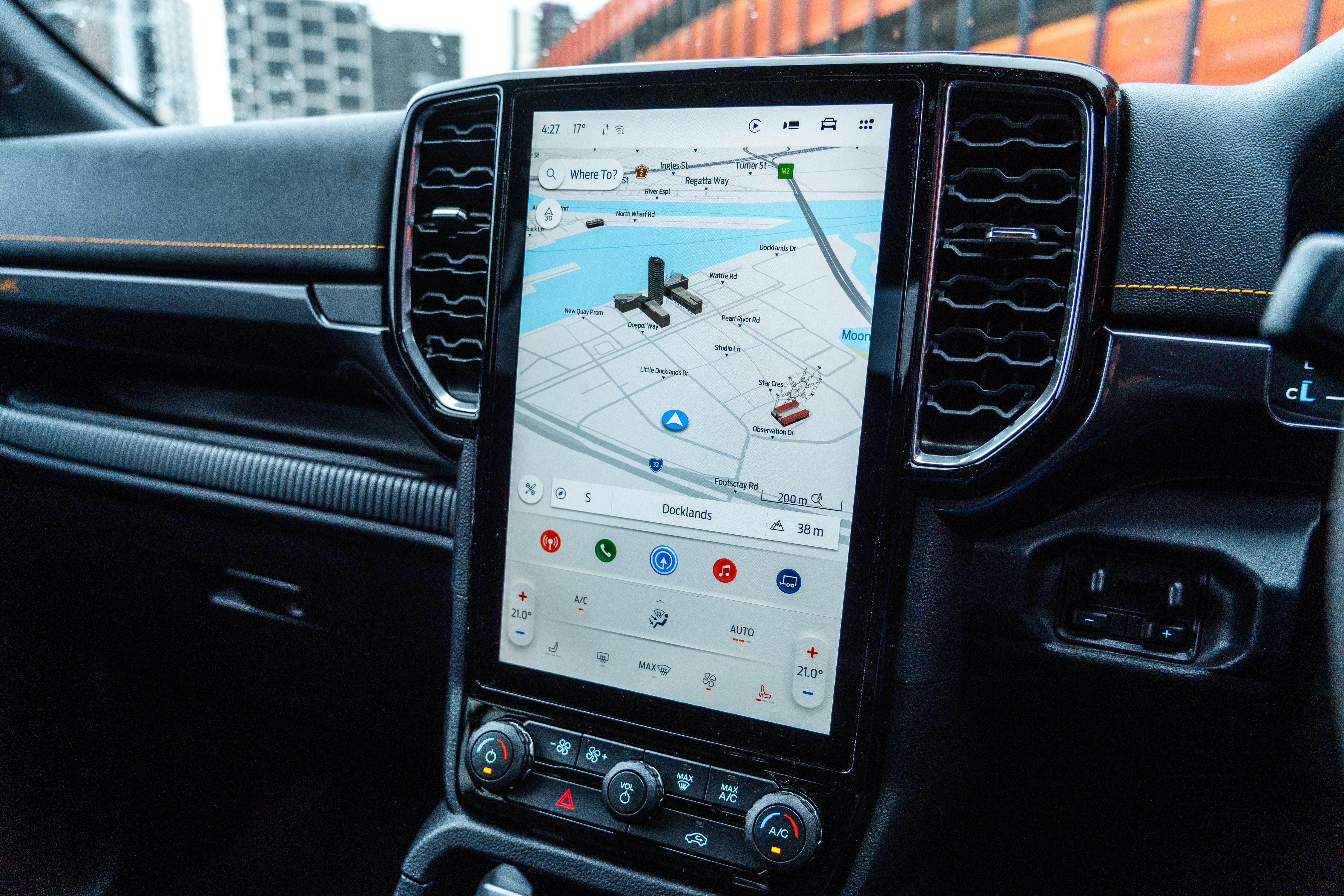
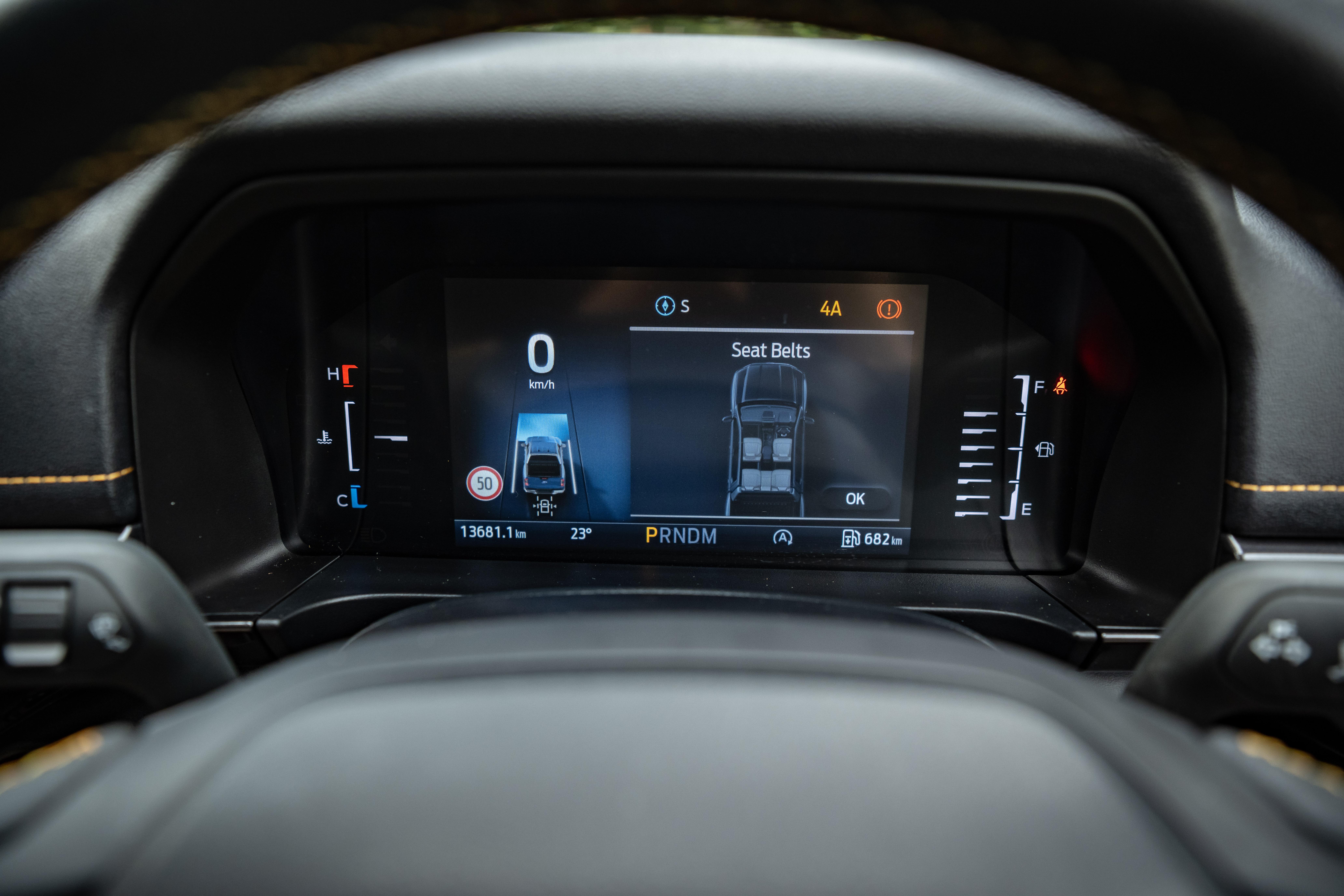
Then there’s the tech. The Wildtrak is the cheaper Ranger in the lineup to get the larger 12.0-inch infotainment touchscreen, up from the 10.1-inch unit fitted in every trim level below it.
Actually, that isn’t technically true, because the XLT PHEV gets the 12.0-inch unit too… despite the diesels getting the smaller screen, and it being a lower grade. This is what we mean by mismatched trims and specifications, although it’s only the PHEVs causing the confusion.
But anyway, the Wildtrak’s screen is high-quality and elevates the cabin. The size difference is only subtle, but it isn’t necessarily its dimensions that make it good. Instead, it’s Ford’s software, which brings clean graphics, snappy response times, and loads of settings.
Wireless smartphone mirroring is standard, and we had no issues operating this screen once we were acquainted. We don’t love its white theme though, especially against the darker Apple CarPlay UI, but we like that Ford lets you switch to dark mode.
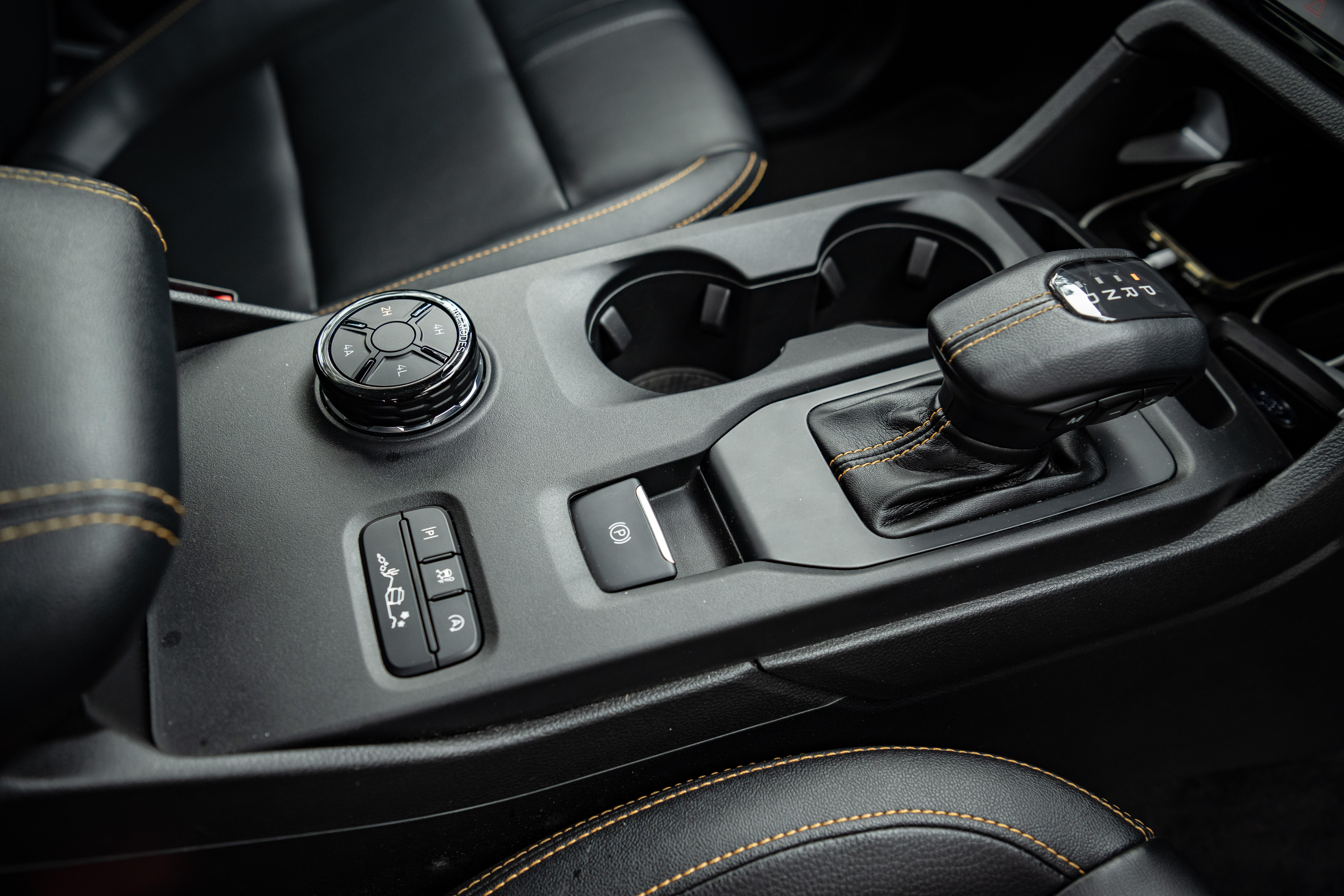
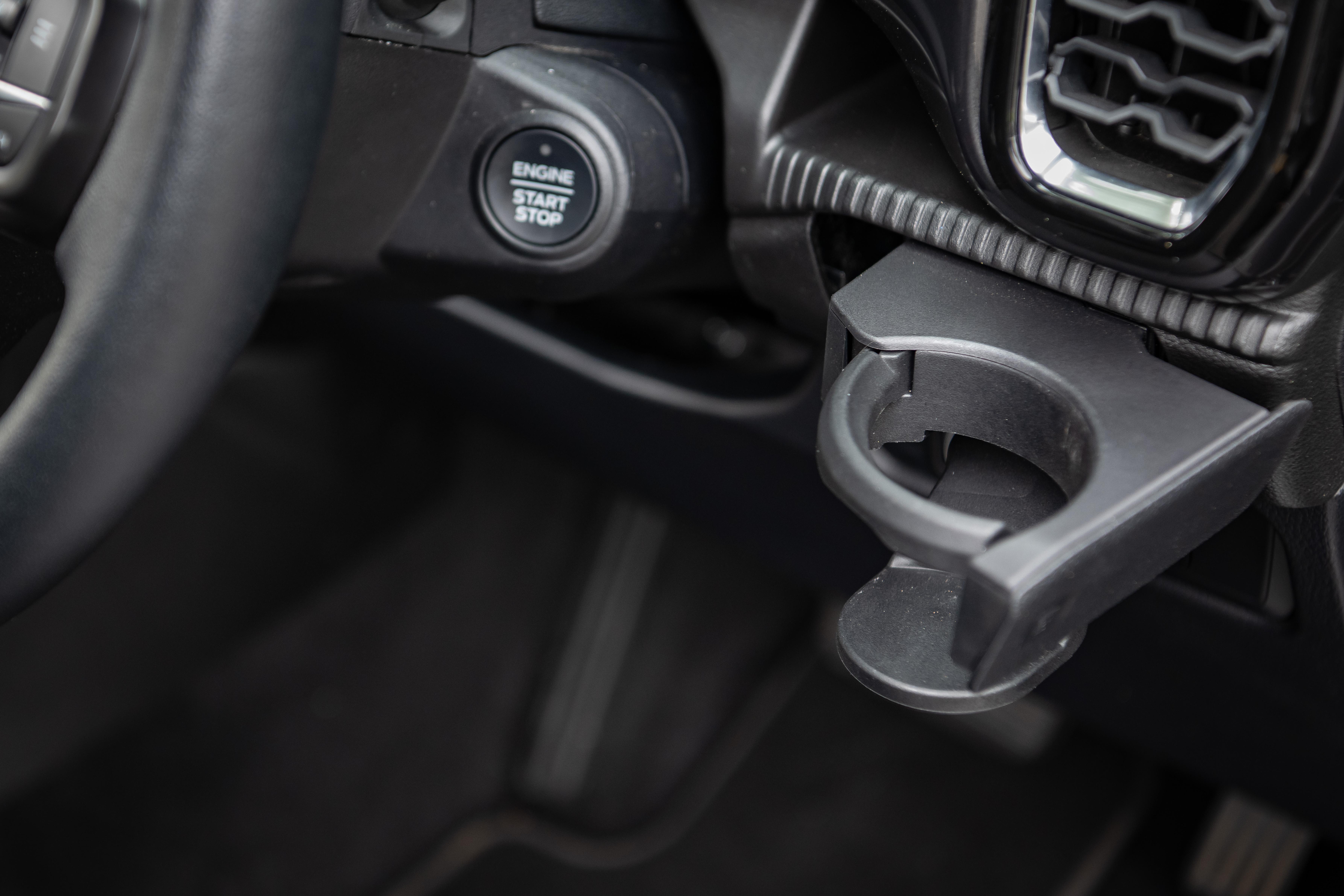
The digital instrument cluster, meanwhile, is nicely sized and offers a plethora of different information. You can customise the amount of info you get too, which means the screen can be as cluttered or as basic as you like.
In fact, there’s almost too much to look through here, and it can be confusing to navigate through using the few buttons on the steering wheel. Time spent playing around to see what everything does will clear things up, but it isn’t as intuitive as some may want.
The cabin’s sheer practicality offsets any of this clunkiness. There are loads of storage options, including four cupholders (including two that fold out from the dashboard), a two-tier glovebox, a central cubby with wireless phone charging and two USB ports (USB-A and -C), and a nicely sized centre console storage box with a 12V outlet inside.
The cabin is functional, comfortable, and aesthetically pleasing, which makes for easy hours behind the wheel.

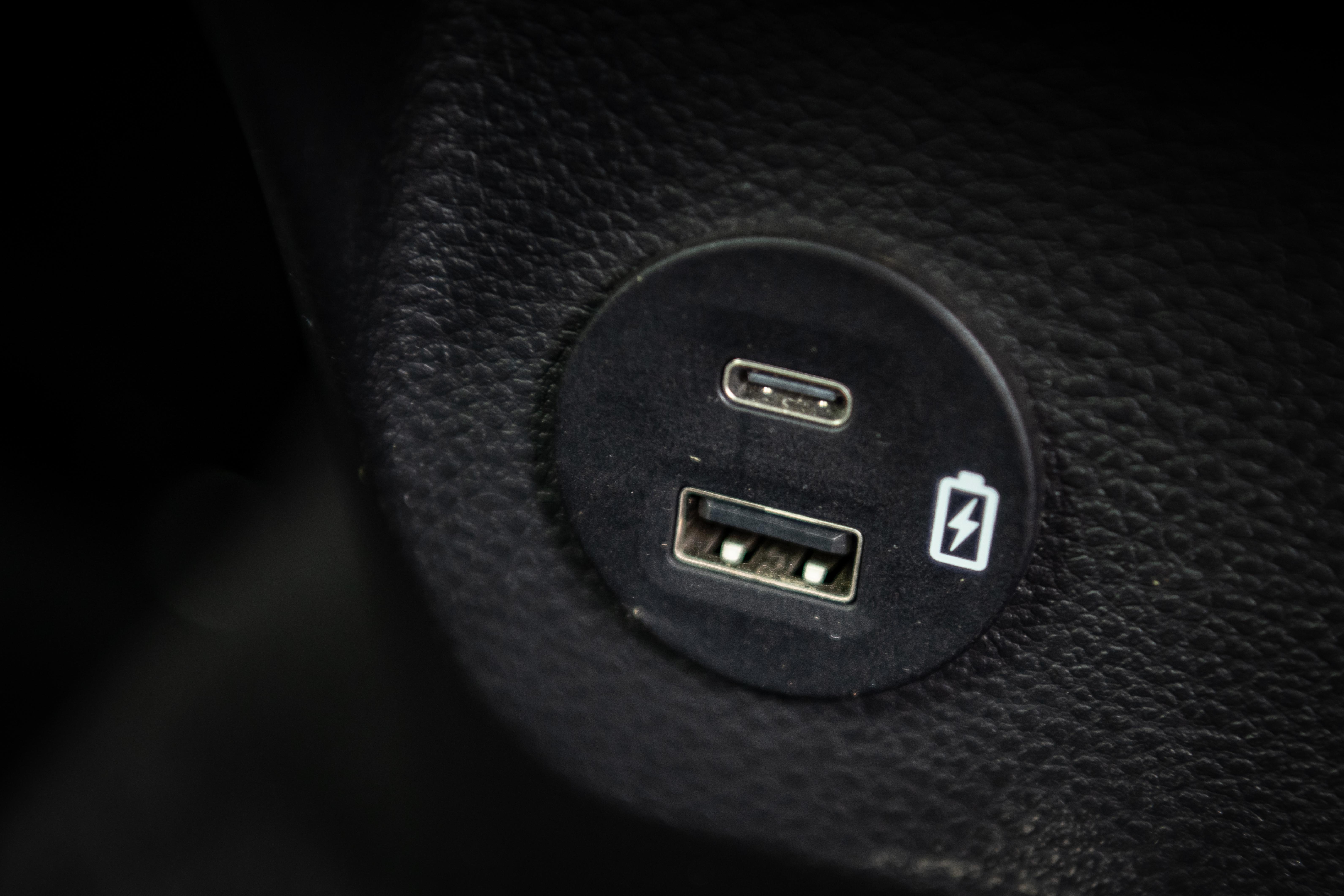
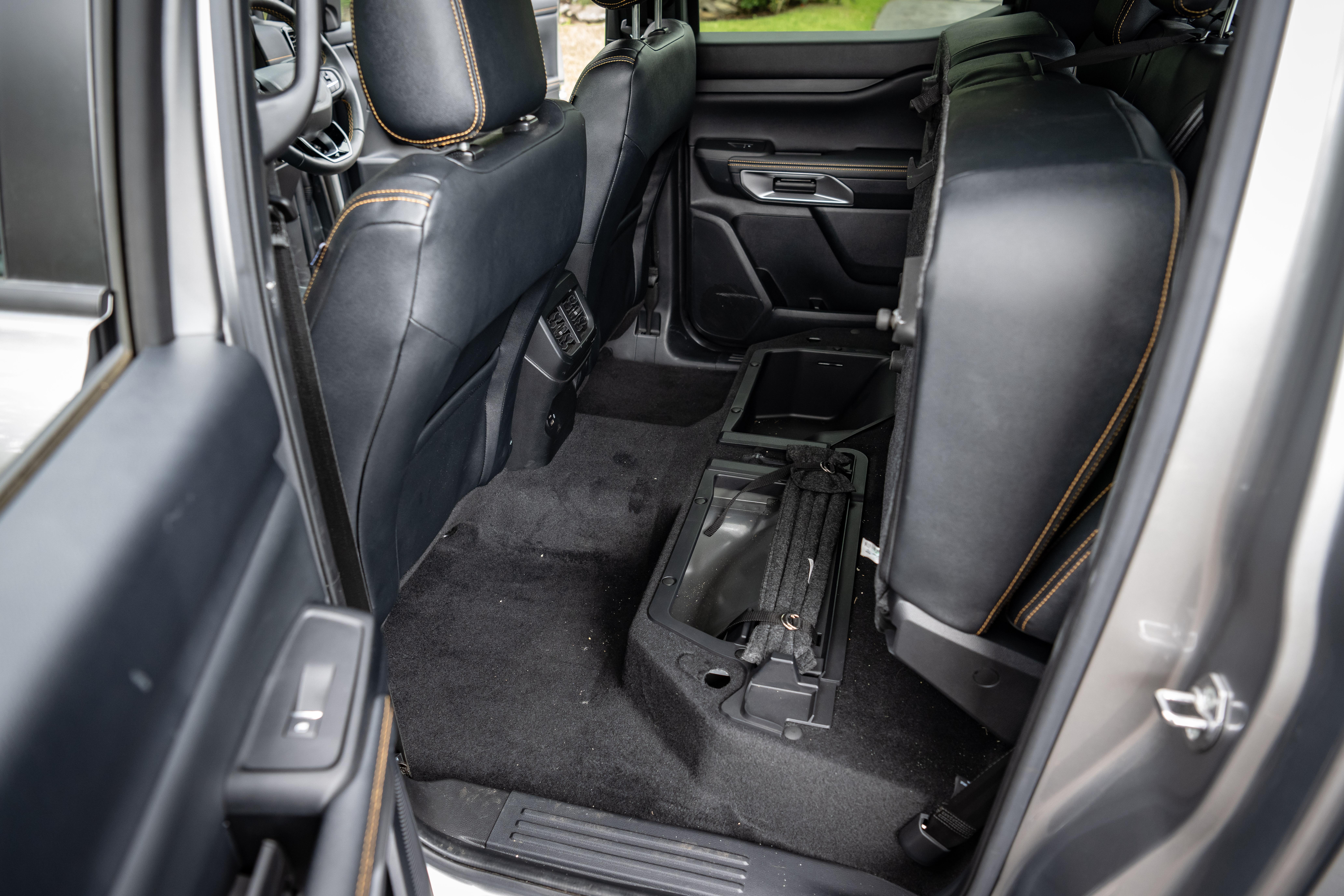

It’s much of the same in the second row, though there isn’t quite as much legroom or headroom as you might expect. At 173cm tall, I had no issues, but taller occupants may feel somewhat cramped, especially if sitting behind a tall driver.
The leather upholstery is fairly slippery too, and there’s nowhere near the same level of side bolstering as offered by the front seats. That means occupants will be sliding around a fair bit in corners, which isn’t too unexpected for a ute.
There is the advantage of dual rear-facing air vents, a pair of USB ports, and a 400W socket, while there’s a soft padded fold-down armrest in the middle with two cupholders. ISOFIX anchors and top-tether points for child seats are also fitted in the outboard seats.
If you need extra cargo space and don’t want to use the tub, the rear bench can either fold up or down to accommodate. Folding it up reveals a couple of cubbies in the floor, while folding down reveals a plastic-lined bulkhead with an Easter egg: the original Ranger logo.
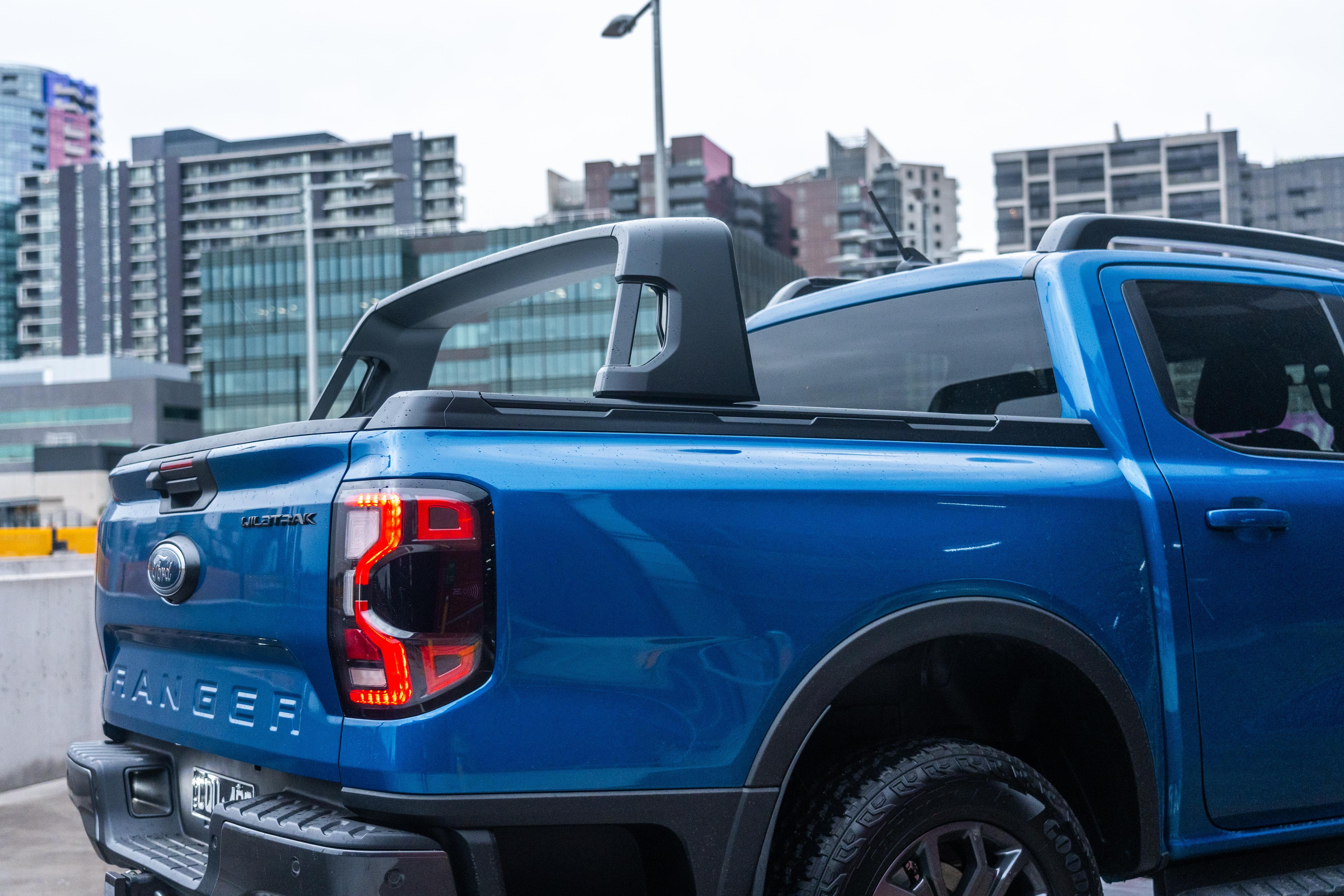
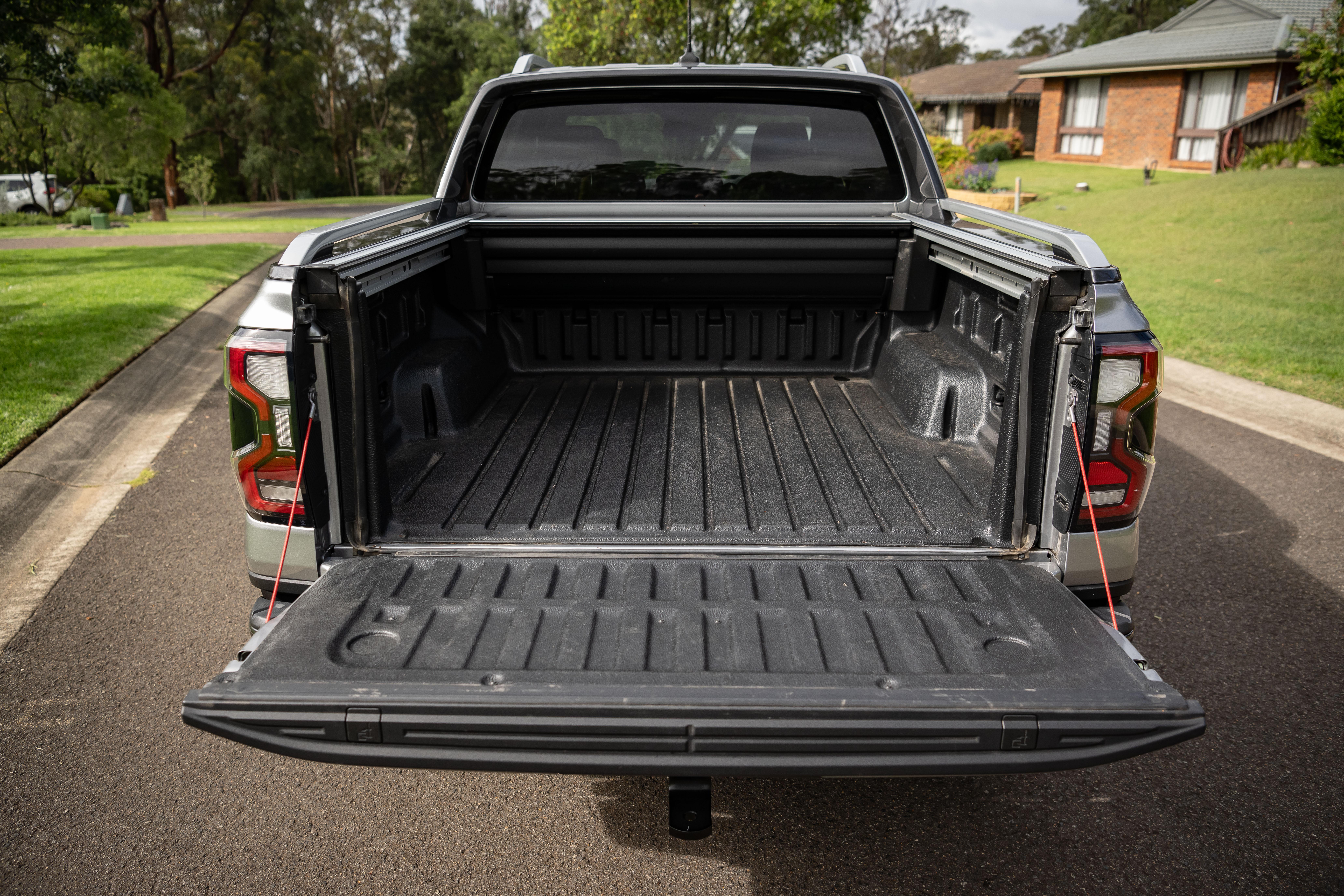
The tub is almost as practical as it gets. We like the inclusion of a powered, rolling tonneau cover, though the area for it to roll up into and the electric mechanism eats into vertical space at the very front.
There aren’t any hydraulic dampers fitted to the tailgate, so it can come crashing down if you’re not careful when opening it. Ford’s brochure says the Wildtrak gets a “Tailgate with Lift Assistance”, but it still feels fairly heavy.
You’ll also notice our blue tester was fitted with Ford’s optional Flexible Rack System, which costs $2800 extra. Replacing the Wildtrak’s standard Sports Sailplane, it’s a sleek unit that can slide into various positions atop the bed, giving you an additional point to secure long items to the roof that wouldn’t otherwise fit.
Additionally, a 400W power inverter is fitted to the tub as standard, as is a 400W power socket.
| Dimensions | Ford Ranger Wildtrak bi-turbo |
|---|---|
| Length | 5370mm |
| Width | 1918mm |
| Height | 1886mm |
| Wheelbase | 3270mm |
| Tub length (at floor) | 1464mm |
| Tub width (total) | 1520mm |
| Tub depth | 525mm |
To see how the Ford Ranger stacks up against its rivals, use our comparison tool.
What’s under the bonnet?
Rangers like our tester are fitted with a 2.0-litre four-cylinder bi-turbo diesel engine, producing 154kW of power and 500Nm of torque. They’re exclusively available with a part-time four-wheel drive system and a 10-speed automatic transmission.
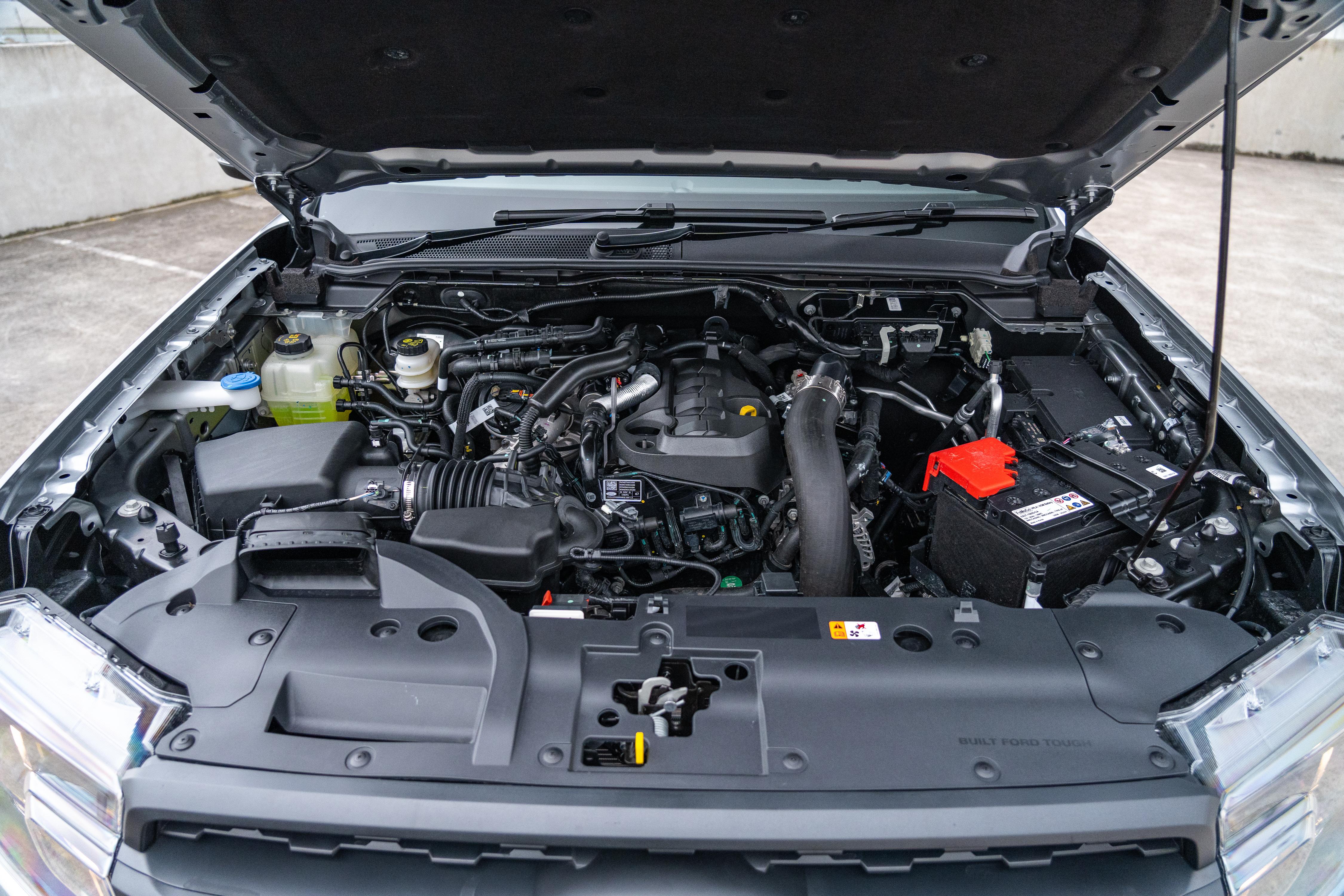
| Specifications | Ford Ranger Wildtrak bi-turbo |
|---|---|
| Engine | 2.0L 4cyl bi-turbo diesel |
| Power | 154kW |
| Torque | 500Nm |
| Transmission | 10-speed automatic |
| Drive type | Part-time 4×4 |
| Fuel economy (claimed) | 7.2L/100km |
| Fuel economy (as tested) | 8.2L/100km |
| CO2 emissions (claimed) | 189g/km |
| Fuel tank | 80L |
| Kerb weight | 2341kg |
| Payload | 939kg |
| Braked towing capacity | 3500kg |
| Gross vehicle mass (GVM) | 3280kg |
| Gross combination mass (GCM) | 6350kg |
Notably, bi-turbo variants don’t have a ‘4A’ setting, so you have to operate in rear-wheel drive on sealed surfaces. In contrast, V6 models do get 4A, which means they can be driven in four-wheel drive at all times – AKA full-time 4×4.
Our week with the Ranger involved primarily highway driving, albeit with lengthy suburban errand-running. Our fuel economy was still noticeably higher than Ford’s claim, even with the idle stop/start system that was introduced halfway through 2024.
The only reason we mention that is because we noticed significantly reduced fuel economy claims for bi-turbo Rangers compared to 2024 (7.2L/100km versus 7.6L/100km), while carbon dioxide emissions were reduced by 12g/km to the 189g/km figure you see above.
It’s hard to believe a stop/start system alone would have such a significant impact, but the fact is real-world fuel efficiency still can’t quite match Ford’s official claim.
To see how the Ford Ranger stacks up against its rivals, use our comparison tool.
How does the Ford Ranger drive?
Even without the buttery V6, getting the Ranger moving quickly reveals why it’s as popular as it is.

We won’t deny the V6 is the preferable option, but there’s a robust sensibility about the bi-turbo. Yes, it’s noticeably more agricultural, and no, it isn’t as powerful, but its performance is likely more than anyone would ever need from a dual-cab.
Its outputs are practically identical to the 2.8-litre HiLux’s, while outperforming the 3.0-litre D-Max and the 2.4-litre Triton. Naturally, that likely means it’s higher-strung than its four-cylinder rivals, which brings reliability into question alongside the famously robust D-Max in particular.
But given the comparatively few recalls for the bi-turbo compared to its V6 sibling, it may have a slight edge in terms of reliability within the Ford stable.
Either way, performance is strong, and it keeps the Wildtrak happily chugging along regardless of the driving conditions or driving demands. It still feels largely SUV-like, with the difference in refinement being negligible in the context of light commercial vehicles.

The bi-turbo also offers strong throttle response, making its power delivery predictable, and it’s less likely to light up the rear wheels than the punchy V6. It’s slightly interrupted by the Ranger’s 10-speed gearbox, which – as is the case with most mainstream modern Fords – simply has too many gears.
As we’ve said in previous reviews of these 10-speed vehicles, that number of gears doesn’t feel entirely necessary when the engines produce as much torque as they do. It’s not like the engine needs help staying in its torque band when 500Nm is consistently on tap, or that it’s going to bog down if geared too high.
Still, the 10-speed is a competent transmission, shifting at the right times (albeit very often) and doing so smoothly. There’s no PHEV-related electric assistance to confuse its computer either, which means the transmission’s behaviour is consistently strong.
Like the engine, it also feels slightly better refined than the more traditional six- or eight-speed units fitted to direct ute rivals, but an Isuzu-style eight may still be more appropriate.

A perceivable disadvantage with the bi-turbo is that it doesn’t offer full-time four-wheel drive, contrasting the V6. Rear-wheel drive is still ideal for both fuel economy, but situations where traction isn’t gauranteed, like towing up a hill in the wet, would still be made easier by full-time 4WD.
You do still have the benefit of high- and low-range four-wheel drive, but both can only be used on unsealed surfaces. There’s a large dial on the centre console to switch between the two, right next to the button to adjust drive modes.
The bi-turbo gets the same modes as most of the other Rangers, bar the more extreme Raptor. That means there are dedicated settings for towing, economy, and a handful of off-road scenarios – enough to harness the best of the Wildtrak’s capabilities.
There’s also a locking rear differential and hill descent control as standard, which are operated using Ford’s trademark off-road screen on the infotainment display.
For a detailed look at the Ranger’s off-road capabilities, check out our video review below:
As for ride and handling, the Ranger is surprisingly composed, again playing into its SUV vibe. Our Wildtrak tester did lose some on-road finesse with all-terrain tyres fitted, but there are still very few complaints from the front-end around turns.
Its suspension is soft enough to be comfortable, but doesn’t compromise body control or commercial capabilities. The Ranger is still the benchmark for utes in terms of the compromise between ride, handling, and capability.
The steering is also nicely weighted and suits a vehicle of the Ranger’s intent, while providing enough feel and feedback.
Road noise levels are acceptable, even with the chunkier all-terrain tread. Wind noise is also relatively well suppressed and, while it’s not completely silent, it won’t annoy you on long freeway stints.
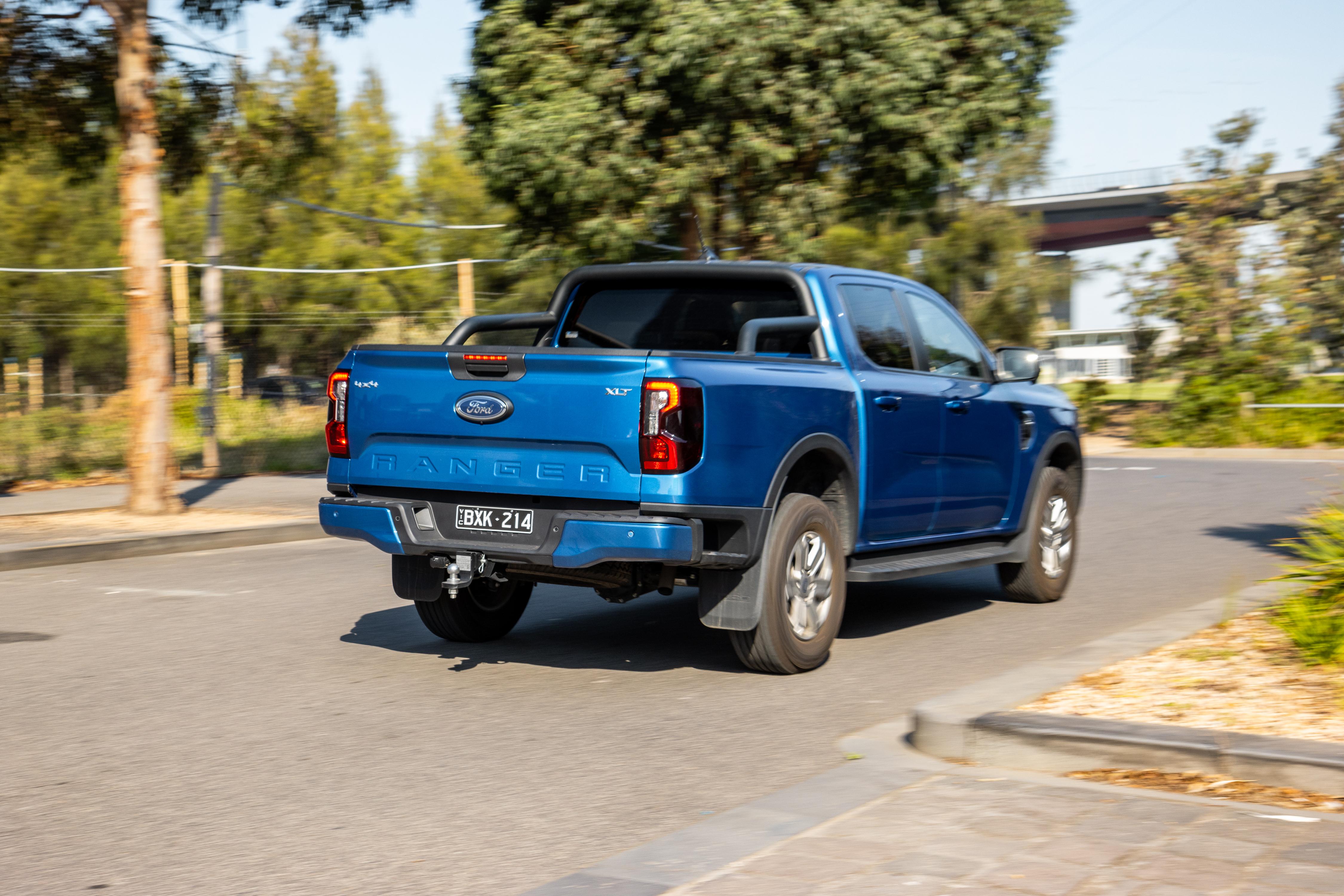
The Ranger also offers a cohesive suite of effective and intuitive safety gear. Previous complaints about its odd and often misplaced warnings to keep our hands on the steering wheel seem to have been fixed, as no such issues cropped up this time around.
The only time we saw warnings from the car’s safety systems was when we genuinely strayed over lane markings (safely, of course), suggesting good calibration across the board.
We also found the Ford’s intelligent cruise control reliable, confidently following the vehicle’s chosen lane on the freeway while reacting appropriately to changes in traffic. You will still be prompted to keep your hands on the wheel if the system detects any fading attention, but that’s fair enough.
Capping it off is generous visibility all round, despite the high bonnet line, with parking supported by a surround-view camera and a multitude of sensors. Plus, it’s impossible to be blindsided with side mirrors this large.
| Off-road dimensions | Ford Ranger Wildtrak |
|---|---|
| Track front and rear | 1620mm |
| Ground clearance | 234mm |
| Approach angle | 30.0º |
| Departure angle | 23.0º |
| Ramp breakover angle | 21.0º |
| Wading depth | 800mm |
To see how the Ford Ranger stacks up against its rivals, use our comparison tool.
What do you get?
There are eight distinct trim levels in the Ranger lineup, with the Wildtrak slotting in towards the top.
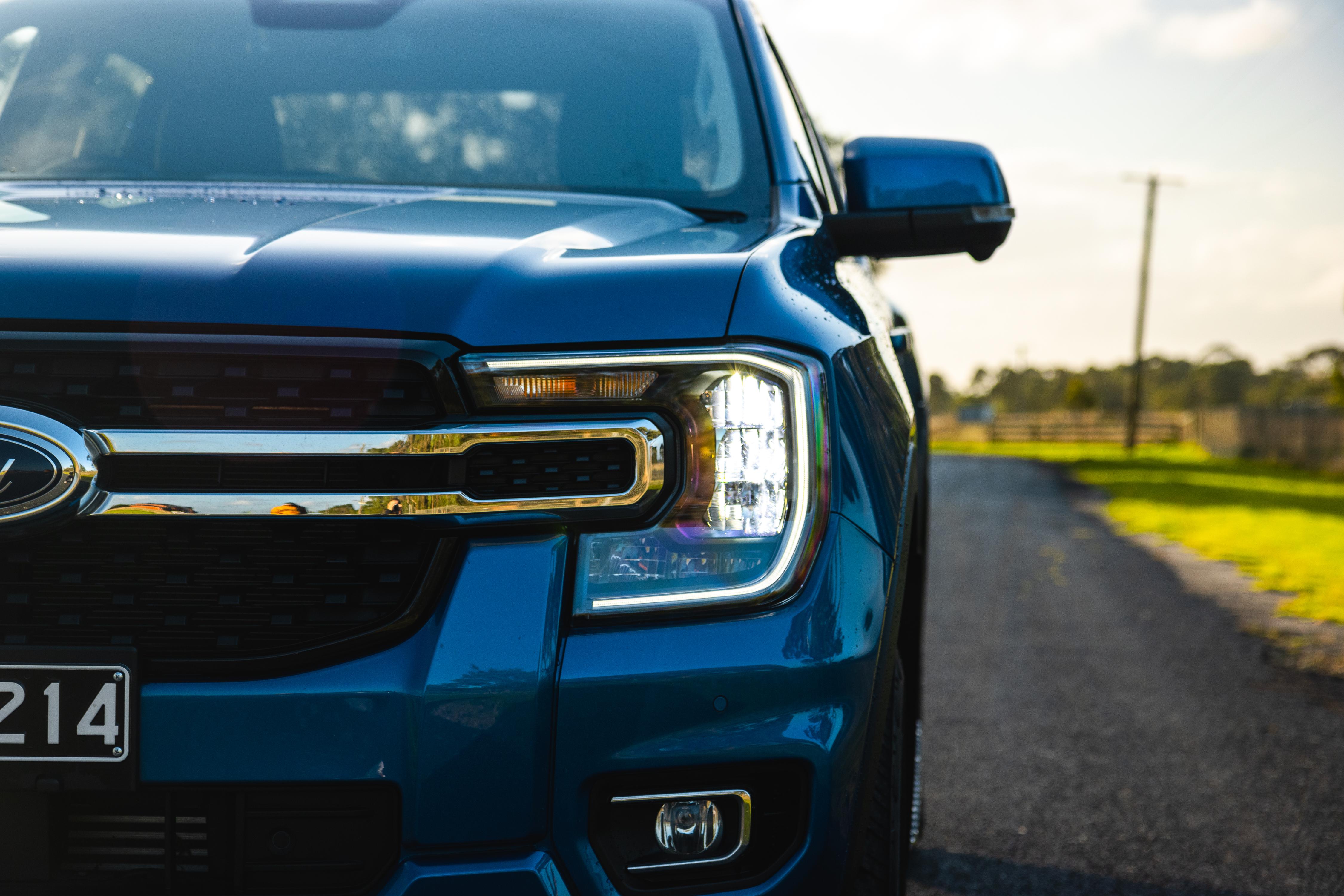

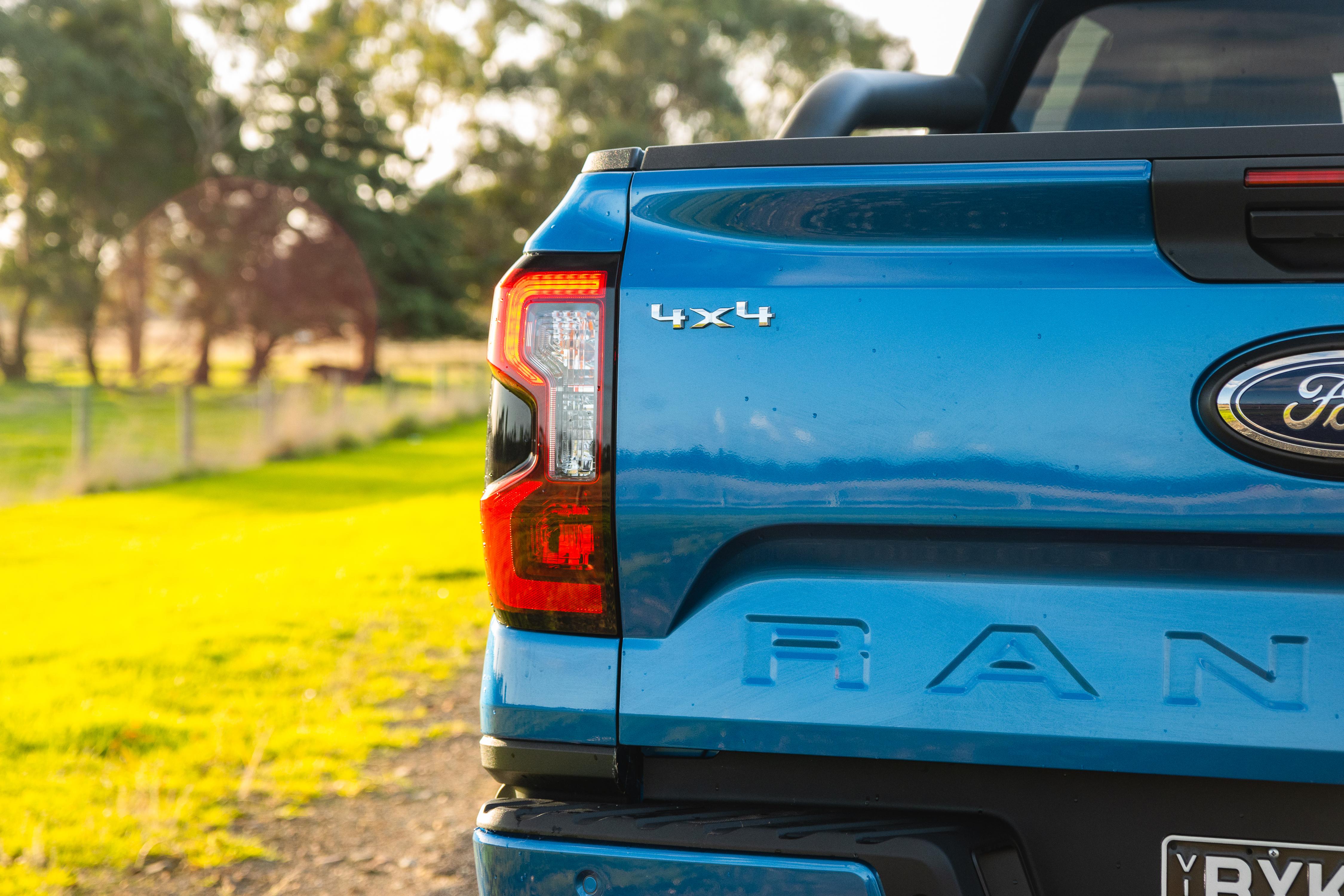
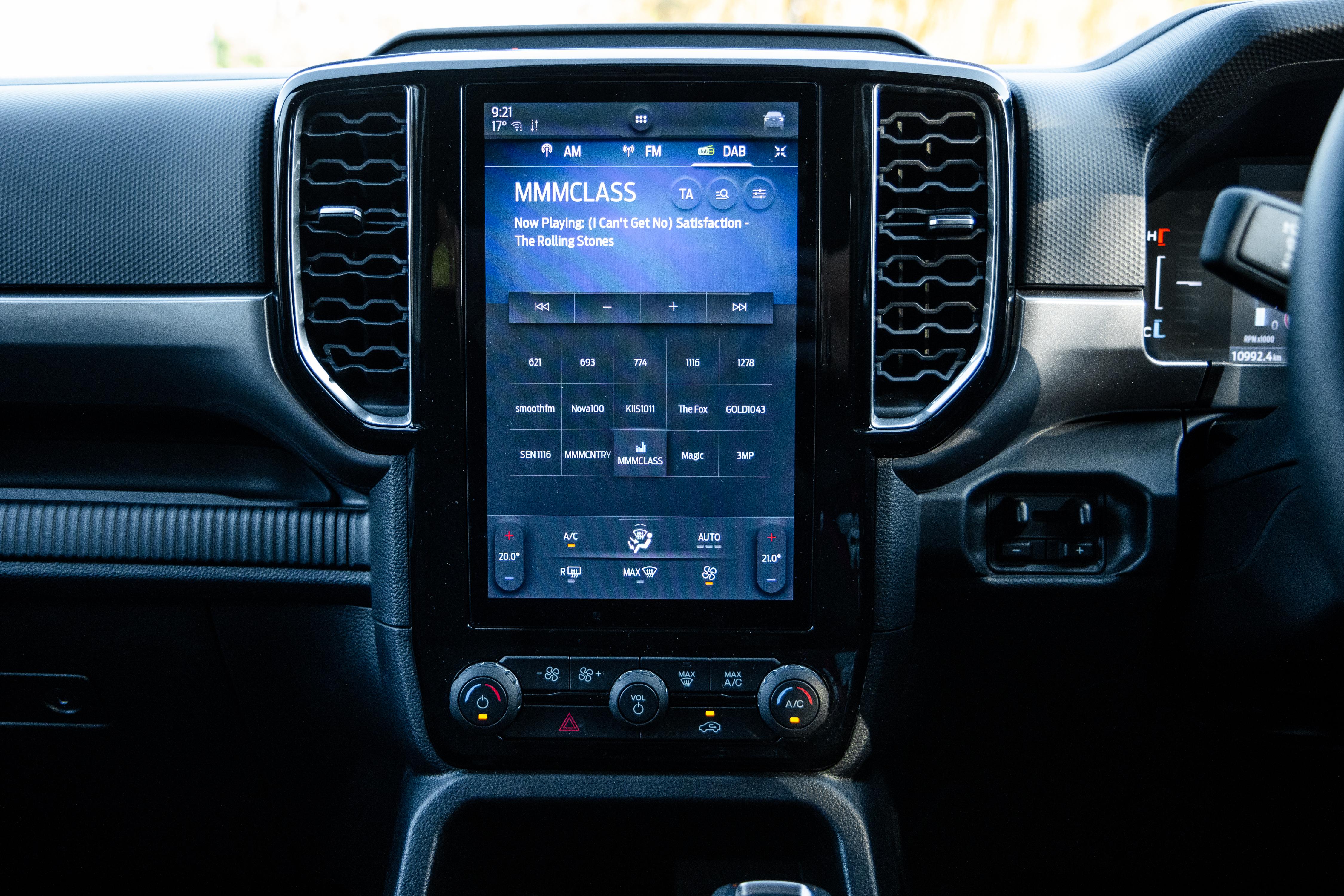
2026 Ford Ranger XL equipment highlights:
- Acoustic windscreen
- 16-inch steel wheels
- All-season tyres
- 16-inch steel spare wheel
- Front disc and rear drum brakes
- Heavy-duty suspension
- Black grille
- Halogen headlights
- Halogen daytime running lights
- LED central high-mounted tail light
- LED tail-lights (pickup only)
- Tailgate with lift assist (pickup only)
- Integrated tailgate step (pickup only)
- 10.1-inch Sync4 portrait touchscreen infotainment system
- Wireless Apple CarPlay and Android Auto
- Embedded modem
- Remote start via FordPass app
- 8.0-inch digital instrument cluster
- Tilt and telescopic steering column adjustment
- Ebony cloth upholstery
- Eight-way manual driver seat
- Four-way manual front passenger seat
- Vinyl floor covering
- Power rear windows (dual-cab only)
- Single-zone climate control
- Electronically locking rear differential (4×4 models only)
- Conventional gear selector
- Mechanical handbrake
Ranger XLS:
- 400-watt power inverter
- 16-inch Dark Sparkle Silver alloy wheels
- Black side steps
- Halogen front fog lights
- Black grille with silver accents
- Carpet flooring
- Driver floor mat
- Drive mode selection
- Tow bar
- Trailer light check
- Integrated trailer brake controller
- Body-colour door handles
- Six-speaker sound system
- Proximity entry with push-button start
- Dual-zone climate control
- Rear seat air vents
- Satellite navigation
- DAB+ digital radio
Ranger XLT adds:
- 17-inch alloy wheels with all-season tyres
- 17-inch steel spare wheel (standard on diesel, no-cost option for PHEV)
- Rear disc brakes
- Electronic handbrake
- Leather-wrapped ‘e-Shifter’ gear selector
- PHEV-specific drive modes:
- Auto EV, EV Now, EV Later and EV Charge
- 2300W interior outlet
- 4×2 locking rear axle
- Front grille with chrome central bar
- LED headlights with C-shaped LED daytime running lights (diesel only, halogen for PHEV)
- Front-mounted tow hook
- Black sports bar (pickup only)
- Rear tub illumination (pickup only)
- Bedliner with 12V socket (diesel pickups only)
- Spray-in bedliner with 12V socket (super cab only)
- 2x 3450W bed outlets (PHEV only)
- 12-inch touchscreen infotainment system (PHEV only)
- Leather-wrapped steering wheel
- Electrochromatic mirror
- Rain-sensing wipers


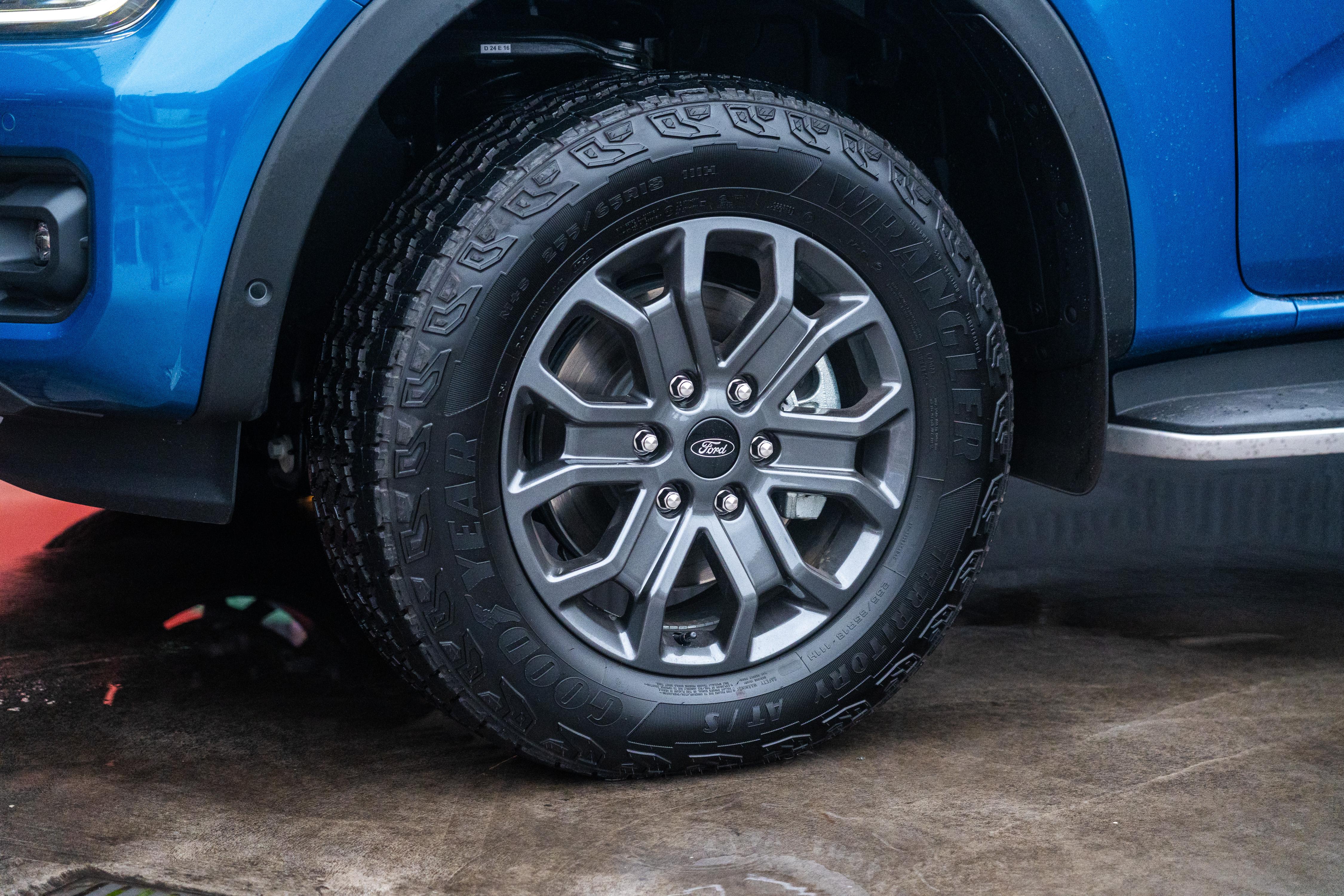

Ranger Sport adds:
- 18-inch alloy wheels
- 18-inch spare wheel
- Dark accent grille
- Dark exterior accents
- Two front-mounted tow hooks
- Skid plate
- LED headlights with C-shaped LED daytime running lights (PHEV only)
- Front floor mats
- Rotary drive mode selector
- Wireless phone charging
- Off-road screen
- 12-inch touchscreen infotainment system (PHEV only)
- Ebony leather upholstery with ‘SPORT’ embossing
- Eight-way power-adjustable driver seat
- Six-way manual front passenger seat
Ranger Wildtrak adds:
- Goodyear Wrangler all-terrain tyres
- Unique Wildtrak sports bar
- Power tub roller shutter
- Cargo management system
- Unique Wildtrak front grille with mesh pattern and Boulder Grey accents
- Exterior side mirrors with puddle lamps and zone lighting
- Roof rails
- Aluminium load box tie-down rails
- 12-inch touchscreen infotainment system
- Ambient lighting
- Pull-out dash-mounted cupholders
- Unique Wildtrak leather-accented upholstery
- Heated front seats
- Eight-way power-adjustable front seats
Our tester featured the optional Flexible Rack System ($2800).
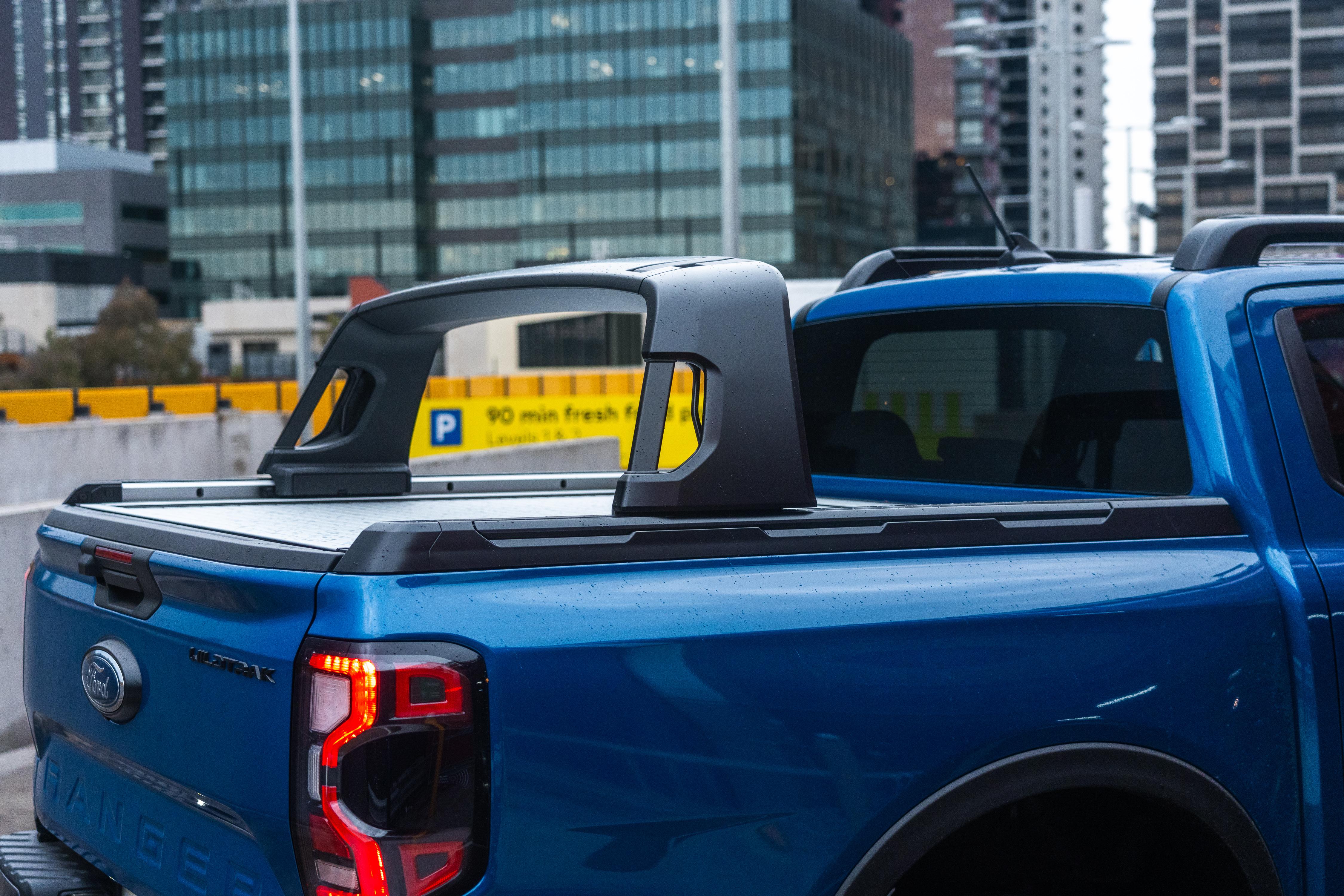
Ranger Platinum adds (over Wildtrak):
- 20-inch alloy wheels
- Goodyear Territory HT tyres
- Silk Chrome exterior trim highlights
- Unique grille
- ‘Platinum’ badging on the bonnet, front doors and tailgate
- Matrix LED headlights
- Auto-levelling LED daytime running lights
- Full LED tail-lights
- Damped (gas-strut) tailgate
- Black paint roof (no-cost option to revert to body-coloured roof)
- Flexible Rack System (FRS)
- Power roller shutter
- 12.4-inch digital instrument cluster
- B&O premium sound system
- Auxiliary switch bank
- Premium floor mats
- Heated steering wheel
- Premium quilted, perforated leather-accented upholstery
- Heated and ventilated front seats
- 10-way electrically adjustable front seats
- Driver memory seat
- ‘Platinum’ badging on front seats, mats and upper glovebox
- Accent stitching and decorative finishes
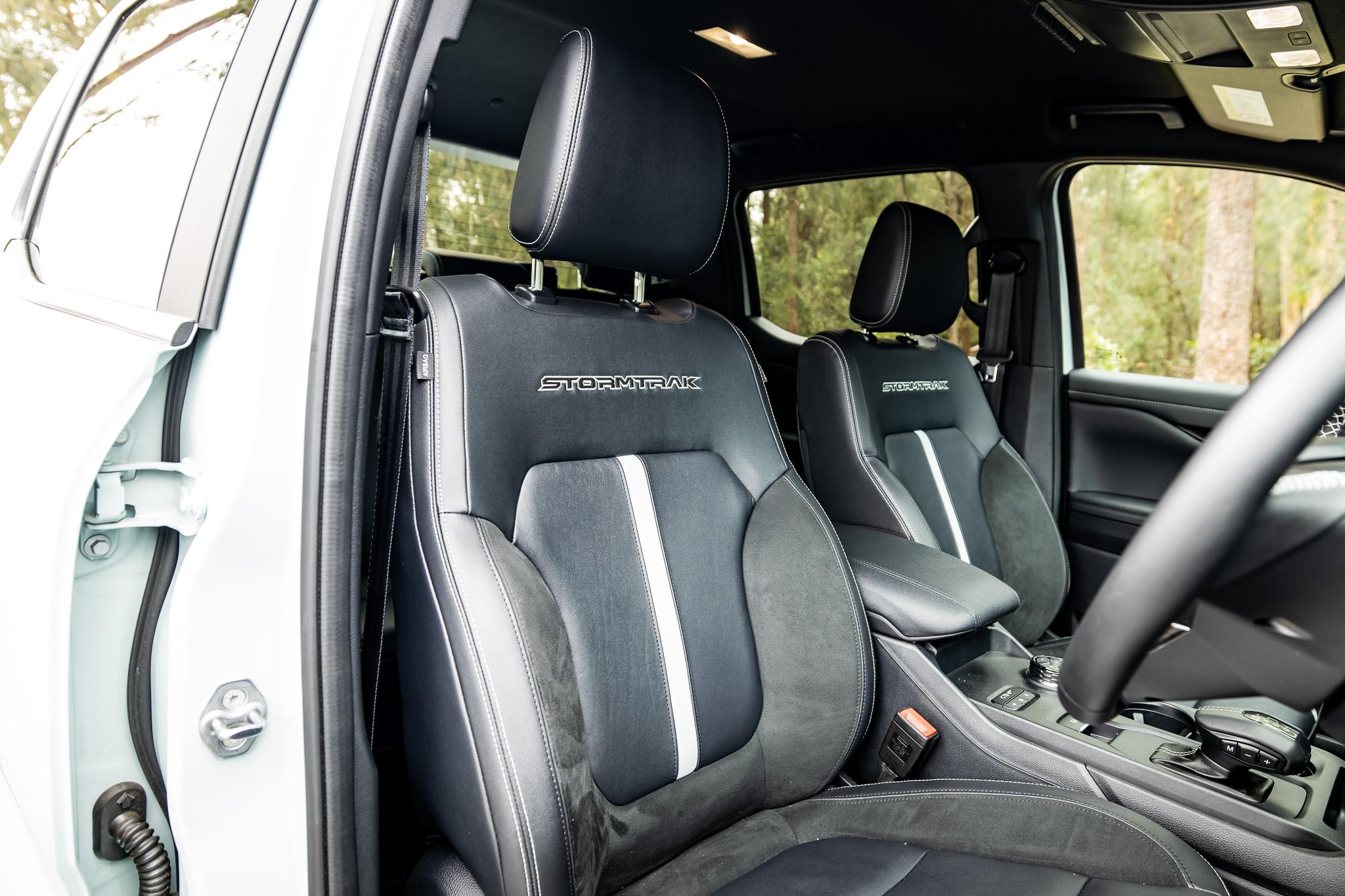
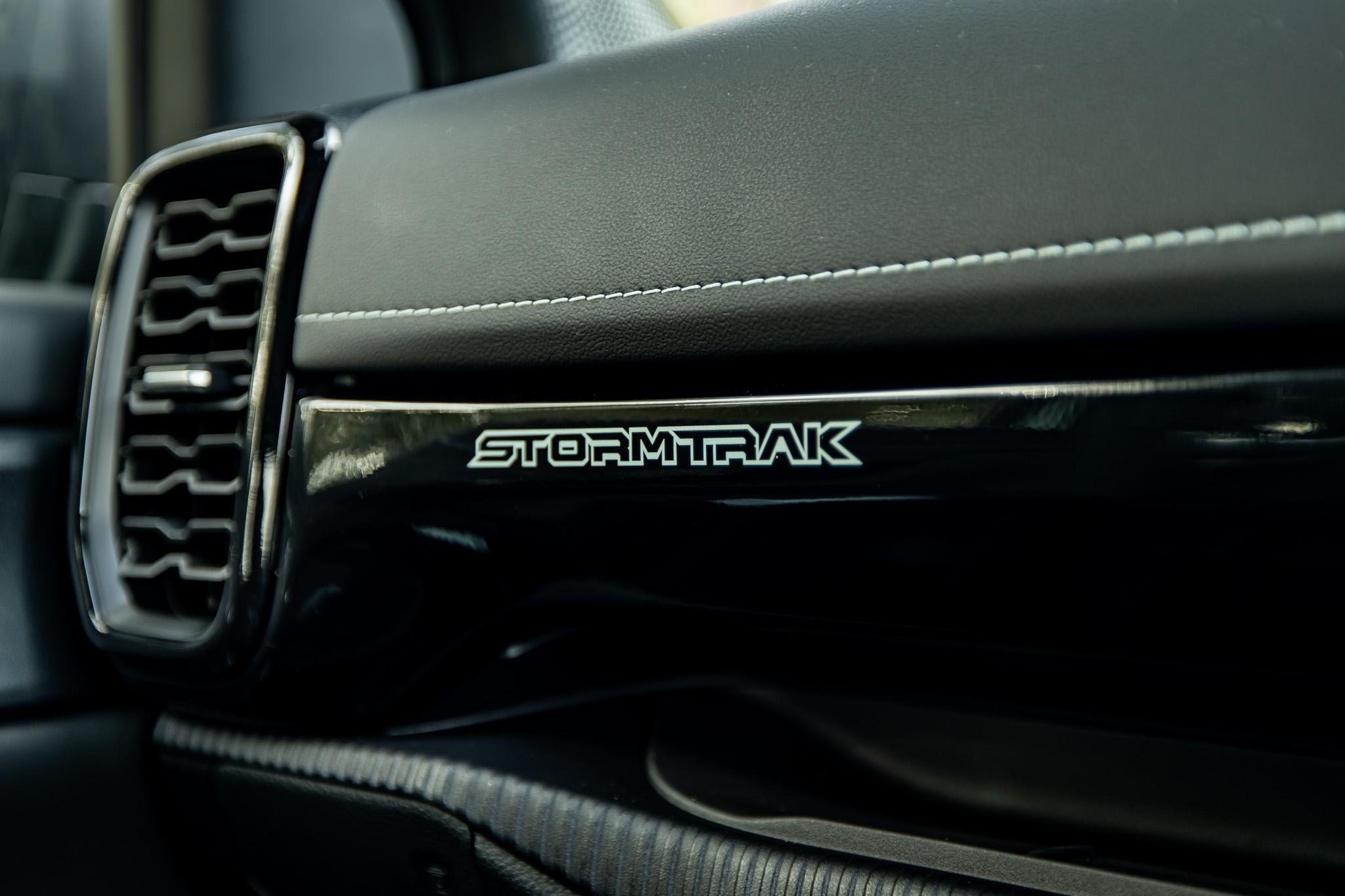

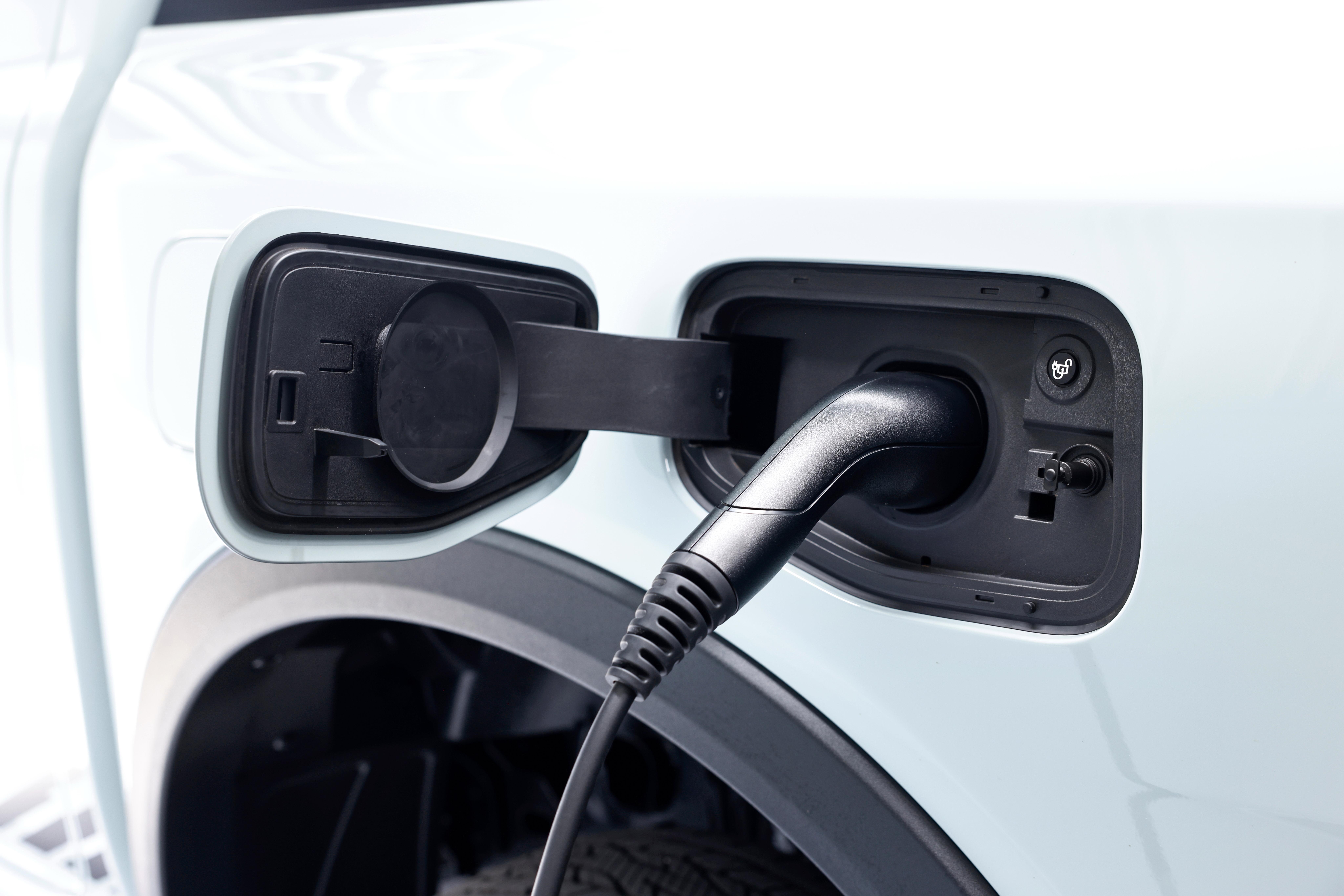
Ranger Stormtrak adds (over Wildtrak):
- Chill Grey wheel highlights
- Body-colour trim
- Thick roof racks
- Matrix LED headlights
- Stormtrak decals
- B&O premium sound system
- Flexible rack system
- Auxiliary switch bank
Ranger Raptor adds (over Wildtrak):
- 17-inch alloy wheels in BF Goodrich K02 all-terrain tyres
- 17-inch alloy spare wheel
- Unique grille with ‘F-O-R-D’ lettering
- LED front fog lights
- Full LED tail-lights
- 2.3mm steel front bash plate
- Unique Raptor dual tow hooks
- Spray-in bedliner
- Active exhaust
- Fox Racing 2.5-inch live valve suspension
- Electronically locking front and rear differentials
- 12.4-inch digital instrument cluster
- 10-speaker B&O premium sound system
- Ambient lighting
- Auxiliary switch bank
- Heated and 10-way power-adjustable Ford Performance seats with embossed Raptor logo and Code Orange accented stitching
- Seven drive modes
- Normal
- Slippery
- Mud/Ruts
- Sand
- Sport
- Baja
- Rock Crawl
To see how the Ford Ranger stacks up against its rivals, use our comparison tool.
Is the Ford Ranger safe?
All variants of the Ford Ranger lineup, apart from the flagship Raptor, have a five-star ANCAP safety rating based on testing conducted in 2022.

| Category | Ford Ranger |
|---|---|
| Adult occupant protection | 84 per cent |
| Child occupant protection | 93 per cent |
| Vulnerable road user protection | 74 per cent |
| Safety assist | 83 per cent |
Standard safety equipment highlights:
- 9 airbags, incl:
- Driver’s knee
- Front-centre
- Passenger’s knee
- Autonomous emergency braking (AEB)
- Car, pedestrian, cyclist detection
- Junction assist
- Adaptive cruise control
- Blind-spot assist
- Rear cross-traffic alert (pickup)
- Lane departure warning
- Lane keep assist
- Road edge detection
- Reversing camera (pickup)
- Rear parking sensors (pickup)
- Trailer Coverage (with optional Tow Pack)
Ranger XLS adds:
- Front parking sensors
- Extended blind-spot monitoring with trailer coverage
Ranger XLT adds:
- Adaptive cruise control incl. stop/go (excl. PHEV)
- Blind-spot monitoring incl. Trailer Coverage
- Lane centring assist (excl. PHEV)
- Traffic sign recognition
- Tyre pressure monitoring
Ranger Sport PHEV adds (over XLT PHEV):
- Intelligent adaptive cruise control incl. stop/go, traffic sign recognition
- Lane centring assist
Ranger Wildtrak PHEV adds (over Sport PHEV):
- Surround-view camera
- Pro trailer back-up assist
To see how the Ford Ranger stacks up against its rivals, use our comparison tool.
How much does the Ford Ranger cost to run?
The 2026 Ford Ranger is covered by a five-year, unlimited-kilometre warranty, like the rest of the Ford range.
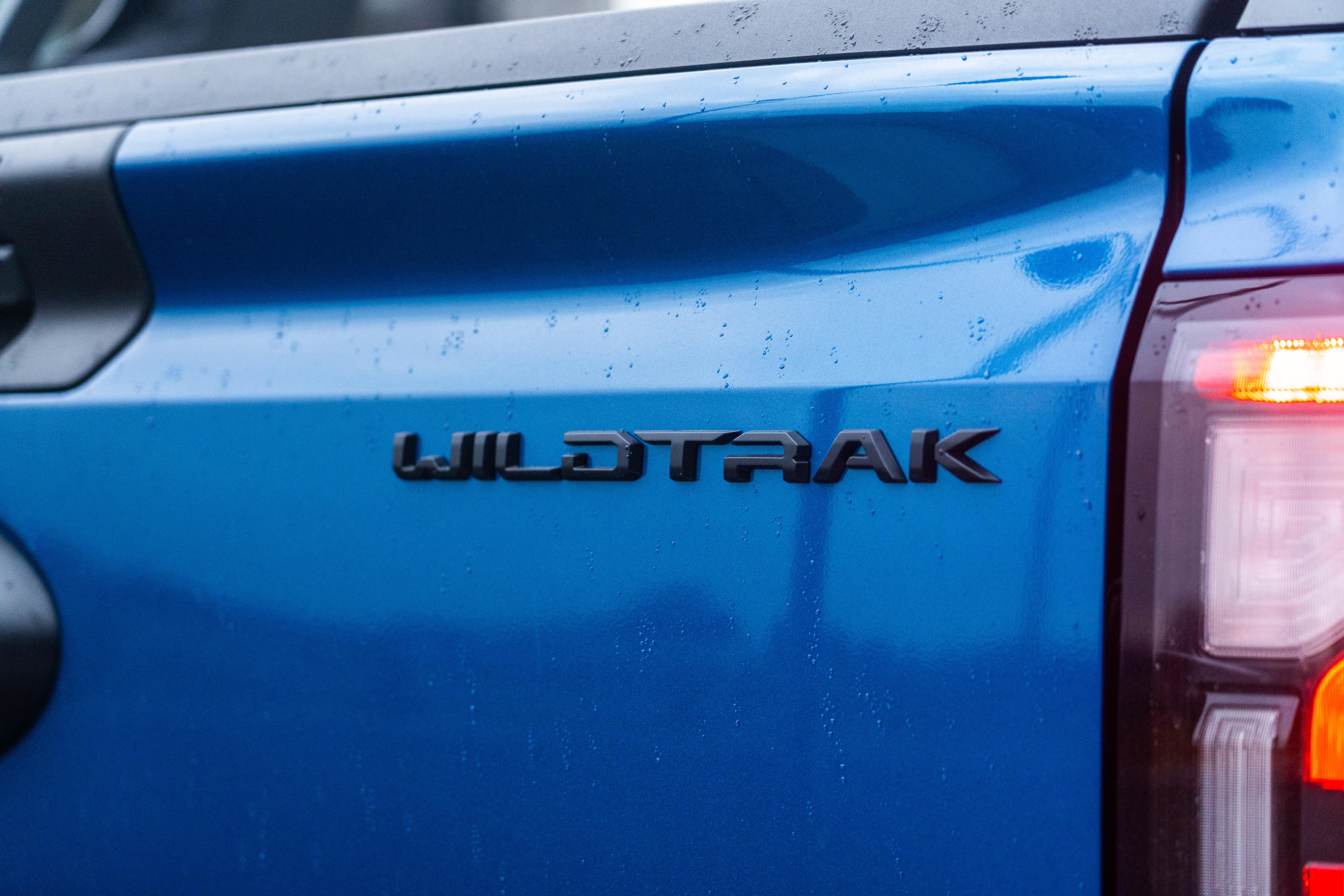
| Servicing and Warranty | Ford Ranger |
|---|---|
| Warranty | 5 years, unlimited kilometres |
| Roadside assistance | 12 months, then service-activated |
| Service intervals | 12 months or 15,000km |
| Capped-price servicing | 5-year pre-paid service plan |
| Total capped-price service cost | $1596 |
Compared to its rivals, servicing costs are competitive. The Toyota HiLux is covered by the same warranty and three years of capped-price servicing, though it has shorter six-month, 10,000km intervals.
Therefore, its first six services are capped at $305, totalling $1830 over three years.
The D-Max, meanwhile, is backed by a six-year, 150,000km warranty and five years of capped-price servicing. Maintenance is required every 12 months or 15,000km, and each service costs $469 for a total of $2345 over five years.
To see how the Ford Ranger stacks up against its rivals, use our comparison tool.
CarExpert’s Take on the Ford Ranger Wildtrak bi-turbo
Put simply, the Wildtrak is a fantastic place to be in the Ranger lineup, offering more than most would ever need from a dual-cab 4×4 ute.
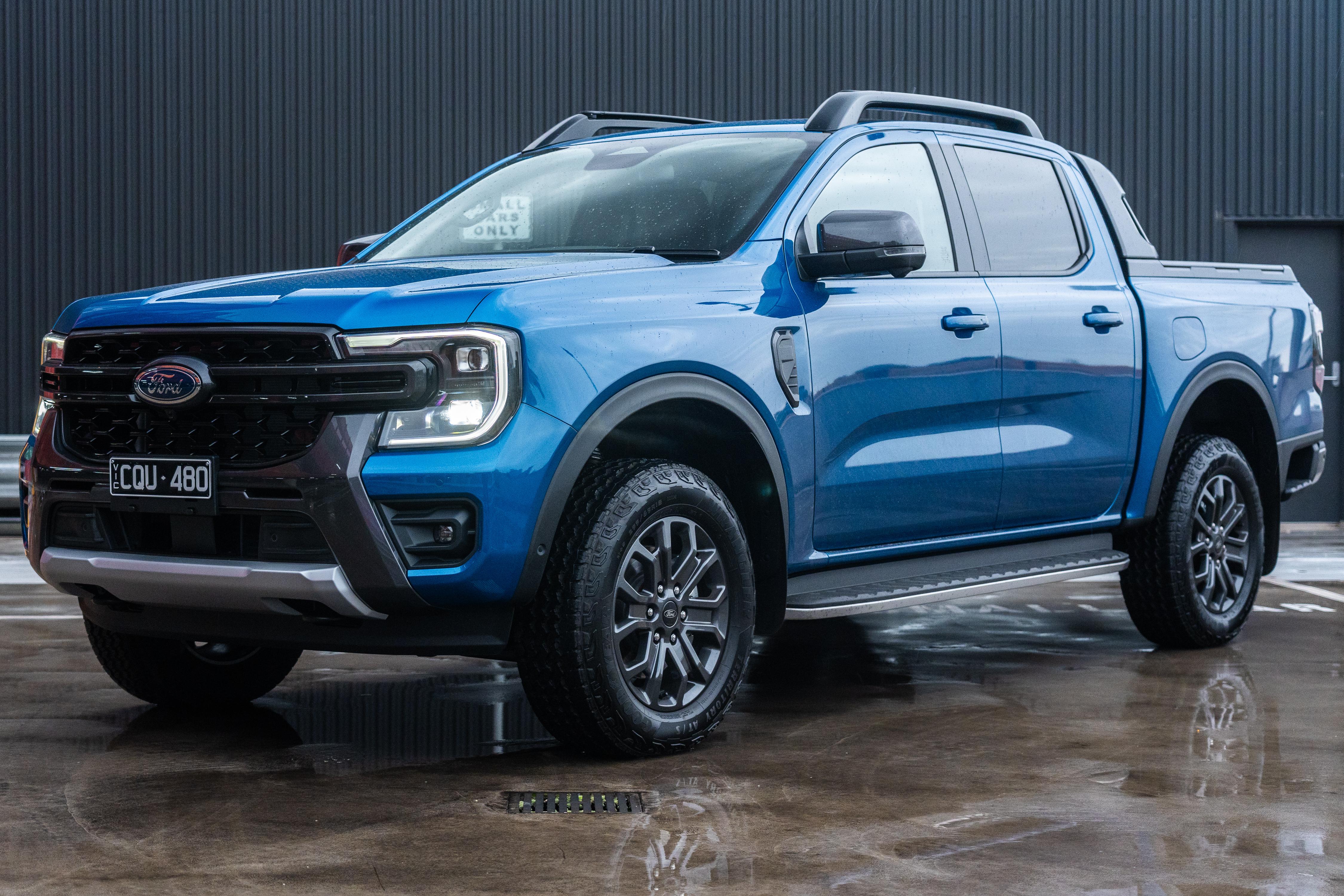
With great ride quality and solid handling – at least for a ute – the Ranger remains well clear of almost all of its rivals in terms of chassis tuning bar maybe the BYD Shark 6, which can’t match it off-road. The Wildtrak builds on that with its upmarket interior, which feels special and very SUV-like even if it lacks the glitter of the Platinum and Stormtrak.
When I reviewed the Ranger Sport V6 earlier this year, I noted that it sat in somewhat of a no-man’s land in the Ranger family – gaining enough over the XLT to feel like a more premium variant, but not missing out on enough to properly distinguish it from the Wildtrak.
I understand that’s a subjective take, but going from the Sport to the model on test here makes the Wildtrak seem far better value, even given the price difference. If you want something that feels a little less ‘lifestyle’, the XLT is where you want to be.
Indeed, the Wildtrak is one of several trim levels available with multiple powertrains, so choosing the best all-rounder may take some deliberation for many.
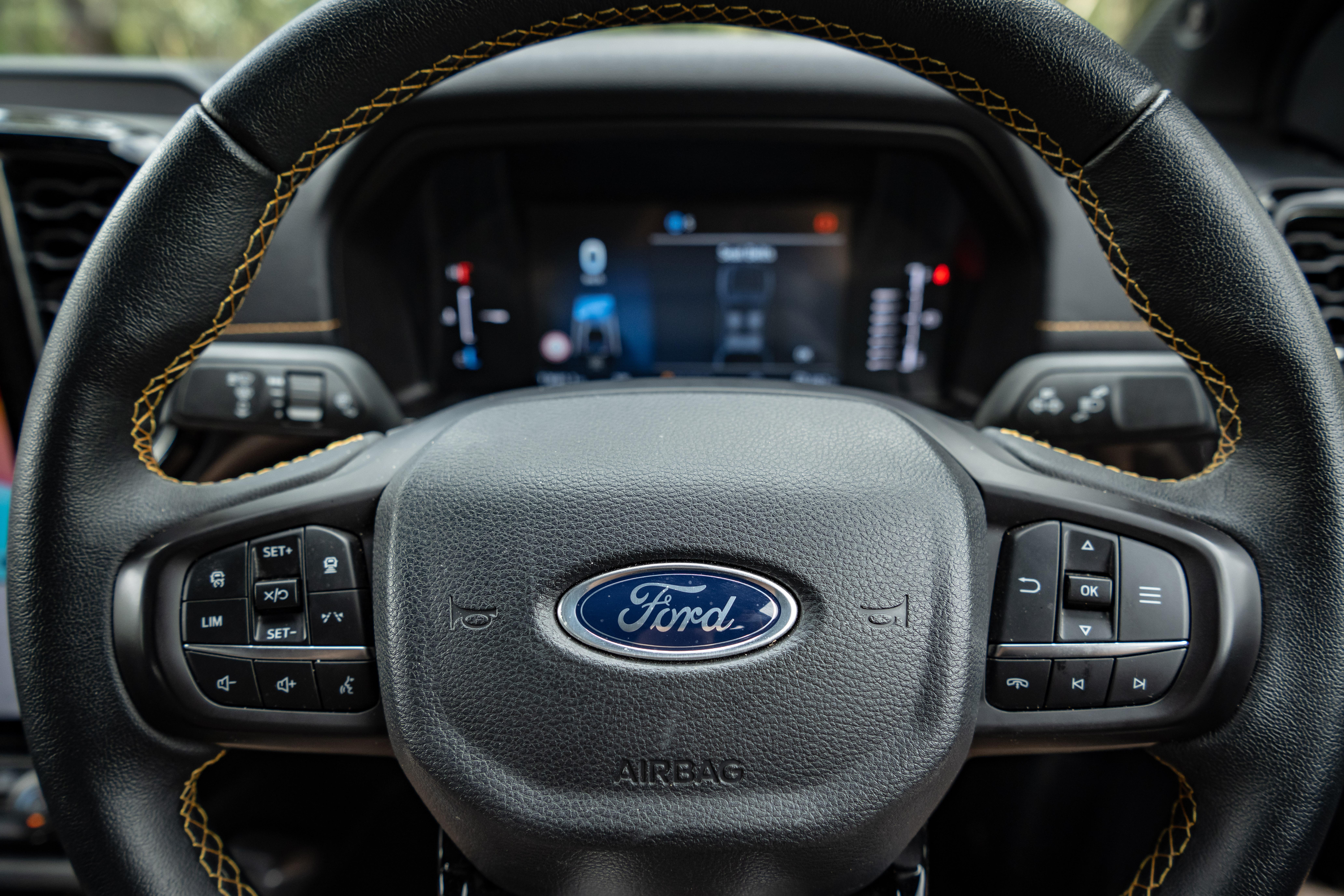
Having driven all three in recent memory, I’d probably point prospective buyers towards the V6 – a choice that has become easier with the bi-turbo’s imminent discontinuation. It’s hard to beat the V6’s performance, smoothness, and full-time 4×4, especially when the Ranger and Amarok are the only two Australian-developed utes with the six-cylinder engine in this size bracket.
But earlier recalls for Ranger and Everest V6 could make the bi-turbo more attractive for paranoid buyers, particularly on run-out, so it’s unfortunate that it won’t be available for much longer.
The PHEV is also a strong option if you prefer the petrol-electric powertrain, but it’s more expensive and more limited in its hybrid capabilities than both the Shark and GWM Cannon Alpha.
All said, the Wildtrak is perfect for both work and play, even if it’s not a bargain buy.

CarExpert can save you thousands on a new Ford Ranger. Click here to get a great deal.
Click the images for the full gallery

